HHS/ACF/OPRE Head Start Classroom-based Approaches and Resources for Emotion and Social skill promotion (CARES) project: Impact and Implementation Studies- Direct Child Assessment
HHS/ACF/OPRE Head Start Classroom-based Approaches and Resources for Emotion and Social skill promotion (CARES) project: Impact and Implementation Studies
OMB CARES 2nd Package_Appendix A.6a_Direct Child Assessment
HHS/ACF/OPRE Head Start Classroom-based Approaches and Resources for Emotion and Social skill promotion (CARES) project: Impact and Implementation Studies- Direct Child Assessment
OMB: 0970-0364
1-,
2-
CASE ID: ____________
HEAD START CARES
DIRECT CHILD ASSESSMENTS QUESTIONNAIRE
INTERVIEWER NAME: ________________________
INTERVIEWER ID NUMBER: _______________ 211-14
SECTION A: INTRODUCTION TO CHILD ASSESSMENTS
A1. TODAY’S DATE: ____/____/_____ 20-27
MM DD YYYY
A2. RECORD CHILD’S NAME: __________________________________
A3. RECORD FOCAL CHILD’S AGE (INDICATED BY COMPUTER)
_________________ YEARS 29-30
A4.
SAY TO CHILD: Now, you and I are going to play some games together. Some will be easy, and some will be hard, but it’s important that you stick with it. At the end, I’ll have a present for you.
CONTINUE TO WOODCOCK JOHNSON
S
2-
B1. GAME: WOODCOCK JOHNSON
OPEN AND SET UP EASEL.
START WITH FIRST ITEM FOR EACH SET.
ALWAYS ADMINISTER A FULL PAGE.
Okay, let’s start.
B2. SUBTEST 1, LETTER-WORD IDENTIFICATION
BEGIN WITH ITEM 1
START: This is the first thing we are going to do. START RECITING BLUE WORDS. READ THE WORDS EXACTLY AS THEY ARE WRITTEN.
2-
Answer
1. |
P |
1 |
0 |
259 |
2. |
E |
1 |
0 |
60 |
3. |
B |
1 |
0 |
61 |
4. |
C |
1 |
0 |
62 |
5. |
k |
1 |
0 |
63 |
6. |
r |
1 |
0 |
64 |
7. |
A |
1 |
0 |
65 |
8. |
D |
1 |
0 |
66 |
9. |
G |
1 |
0 |
67 |
10. |
cat |
1 |
0 |
68 |
11. |
m |
1 |
0 |
69 |
12. |
h |
1 |
0 |
70 |
13. |
t |
1 |
0 |
71 |
14. |
b |
1 |
0 |
72 |
15. |
car |
1 |
0 |
73 |
16. |
on |
1 |
0 |
74 |
17. |
to |
1 |
0 |
75 |
18. |
dog |
1 |
0 |
76 |
19. |
in |
1 |
0 |
77 |
20. |
can |
1 |
0 |
78 |
21. |
as |
1 |
0 |
79 |
22. |
get |
1 |
0 |
80 |
23. |
was |
1 |
0 |
81 |
24. |
have |
1 |
0 |
82 |
25. |
they |
1 |
0 |
83 |
26. |
when |
1 |
0 |
84 |
27. |
there |
1 |
0 |
85 |
28. |
must |
1 |
0 |
86 |
29. |
about |
1 |
0 |
87 |
30. |
only |
1 |
0 |
88 |
31. |
part |
1 |
0 |
89 |
32. |
could |
1 |
0 |
90 |
33. |
because |
1 |
0 |
91 |
34. |
knew |
1 |
0 |
92 |
35. |
own |
1 |
0 |
93 |
36. |
whole |
1 |
0 |
94 |
37. |
against |
1 |
0 |
95 |
38. |
sentence |
1 |
0 |
96 |
39. |
island |
1 |
0 |
97 |
40. |
decide |
1 |
0 |
98 |
99:100-02
A
3-
41. |
since |
1 |
0 |
311 |
42. |
distance |
1 |
0 |
12 |
43. |
usually |
1 |
0 |
13 |
44. |
scientist |
1 |
0 |
14 |
45. |
bounties |
1 |
0 |
15 |
46. |
fierce |
1 |
0 |
16 |
47. |
experience |
1 |
0 |
17 |
48. |
moustache |
1 |
0 |
18 |
49. |
achieved |
1 |
0 |
19 |
50. |
tremendous |
1 |
0 |
20 |
51. |
systematic |
1 |
0 |
21 |
52. |
urged |
1 |
0 |
22 |
53. |
ancient |
1 |
0 |
23 |
54. |
obviously |
1 |
0 |
24 |
55. |
sufficient |
1 |
0 |
25 |
56. |
particularly |
1 |
0 |
26 |
57. |
domesticated |
1 |
0 |
27 |
58. |
interpretation |
1 |
0 |
28 |
59. |
therapeutic |
1 |
0 |
29 |
60. |
bouquet |
1 |
0 |
30 |
61. |
significance |
1 |
0 |
31 |
62. |
provincial |
1 |
0 |
32 |
63. |
aeronautic |
1 |
0 |
33 |
64. |
conspicuous |
1 |
0 |
34 |
65. |
diacritical |
1 |
0 |
35 |
66. |
deficiencies |
1 |
0 |
36 |
67. |
pituitary |
1 |
0 |
37 |
68. |
trivialities |
1 |
0 |
38 |
69. |
debutante |
1 |
0 |
39 |
70. |
magnanimous |
1 |
0 |
40 |
71. |
homogenization |
1 |
0 |
41 |
72. |
indissolubly |
1 |
0 |
42 |
73. |
picaresque |
1 |
0 |
43 |
74. |
ubiquitous |
1 |
0 |
44 |
75. |
argot |
1 |
0 |
45 |
76. |
satiate |
1 |
0 |
46 |
Skip:
347-56
END: WHEN YOU REACH A CEILING, SAY: Great job! Now, let’s play another game.
3-
B3. SUBTEST 10, APPLIED PROBLEMS
BEGIN WITH PAGE 183
START: BEGIN RECITING BLUE TEXT.
NO
RESPONSE: GIVE THE CHILD ABOUT 5 SECONDS TO ANSWER. IF CHILD HAS
NOT ANSWERED, SAY: Do
you want to
take a guess?
IF CHILD STILL DOES NOT ANSWER, CIRCLE “0” AND GO TO
THE NEXT ITEM.
Answer
1. |
1 finger |
1 |
0 |
357 |
2. |
2 fingers |
1 |
0 |
58 |
3. |
1 |
1 |
0 |
59 |
4. |
2 |
1 |
0 |
60 |
5. |
1 |
1 |
0 |
61 |
6. |
2 |
1 |
0 |
62 |
7. |
3 |
1 |
0 |
63 |
8. |
2 |
1 |
0 |
64 |
9. |
2 |
1 |
0 |
65 |
10. |
4 |
1 |
0 |
66 |
11. |
3 and 4 |
1 |
0 |
67 |
12. |
4 |
1 |
0 |
68 |
13. |
2 |
1 |
0 |
69 |
14. |
3 |
1 |
0 |
70 |
15. |
5 |
1 |
0 |
71 |
16. |
4 |
1 |
0 |
72 |
17. |
6 |
1 |
0 |
73 |
18. |
5 |
1 |
0 |
74 |
19. |
7:00 and 2:00 |
1 |
0 |
75 |
20. |
2 |
1 |
0 |
76 |
21. |
4 |
1 |
0 |
77 |
22. |
7 |
1 |
0 |
78 |
23. |
3 |
1 |
0 |
79 |
24. |
quarter and dime |
1 |
0 |
80 |
Answer
25. |
10 cents |
1 |
0 |
381 |
26. |
60 |
1 |
0 |
82 |
27. |
36 cents |
1 |
0 |
83 |
28. |
5 |
1 |
0 |
84 |
29. |
16 cents |
1 |
0 |
85 |
30. |
5 |
1 |
0 |
86 |
31. |
24 dollars |
1 |
0 |
87 |
32. |
15 cents |
1 |
0 |
88 |
33. |
2 quarters, 1 dime, and 1 nickel |
1 |
0 |
89 |
34. |
10 |
1 |
0 |
9
Skip:
391-98 99-100:03 |
35. |
35 cents |
1 |
0 |
411 |
36. |
55 cents |
1 |
0 |
12 |
37. |
132 |
1 |
0 |
13 |
38. |
2 inches |
1 |
0 |
14 |
39. |
6 ½ |
1 |
0 |
15 |
40. |
92 |
1 |
0 |
16 |
41. |
30 |
1 |
0 |
17 |
42. |
2 |
1 |
0 |
18 |
43. |
3 |
1 |
0 |
19 |
44. |
1:15 |
1 |
0 |
20 |
45. |
3 ½ |
1 |
0 |
21 |
46. |
52 dollars |
1 |
0 |
22 |
47. |
30 pounds |
1 |
0 |
23 |
48. |
9 inches |
1 |
0 |
24 |
49. |
$6.21 |
1 |
0 |
25 |
50. |
200 |
1 |
0 |
26 |
51. |
16 |
1 |
0 |
27 |
52. |
920 dollars |
1 |
0 |
28 |
53. |
5,000 cubic feet |
1 |
0 |
29 |
54. |
9 square inches |
1 |
0 |
30 |
55. |
+14 |
1 |
0 |
31 |
56. |
6.4 |
1 |
0 |
32 |
57. |
$1,102.50 |
1 |
0 |
33 |
58. |
between 628.0 and 628.6 feet |
1 |
0 |
34 |
59. |
-⅔ |
1 |
0 |
35 |
60. |
1 to 36 |
1 |
0 |
36 |
61. |
between 43.9 and 44 inches |
1 |
0 |
37 |
62. |
Altitude = 6 inches and base = 10 inches |
1 |
0 |
38 |
63. |
between 5½ and 6 inches |
1 |
0 |
39 |
END: WHEN YOU REACH A CEILING, SAY: Great job! Now, let’s play another game.
PUT WOODCOCK-JOHNSON AWAY.
SECTION C: EXPRESSIVE ONE-WORD
PICTURE VOCABULARY TEST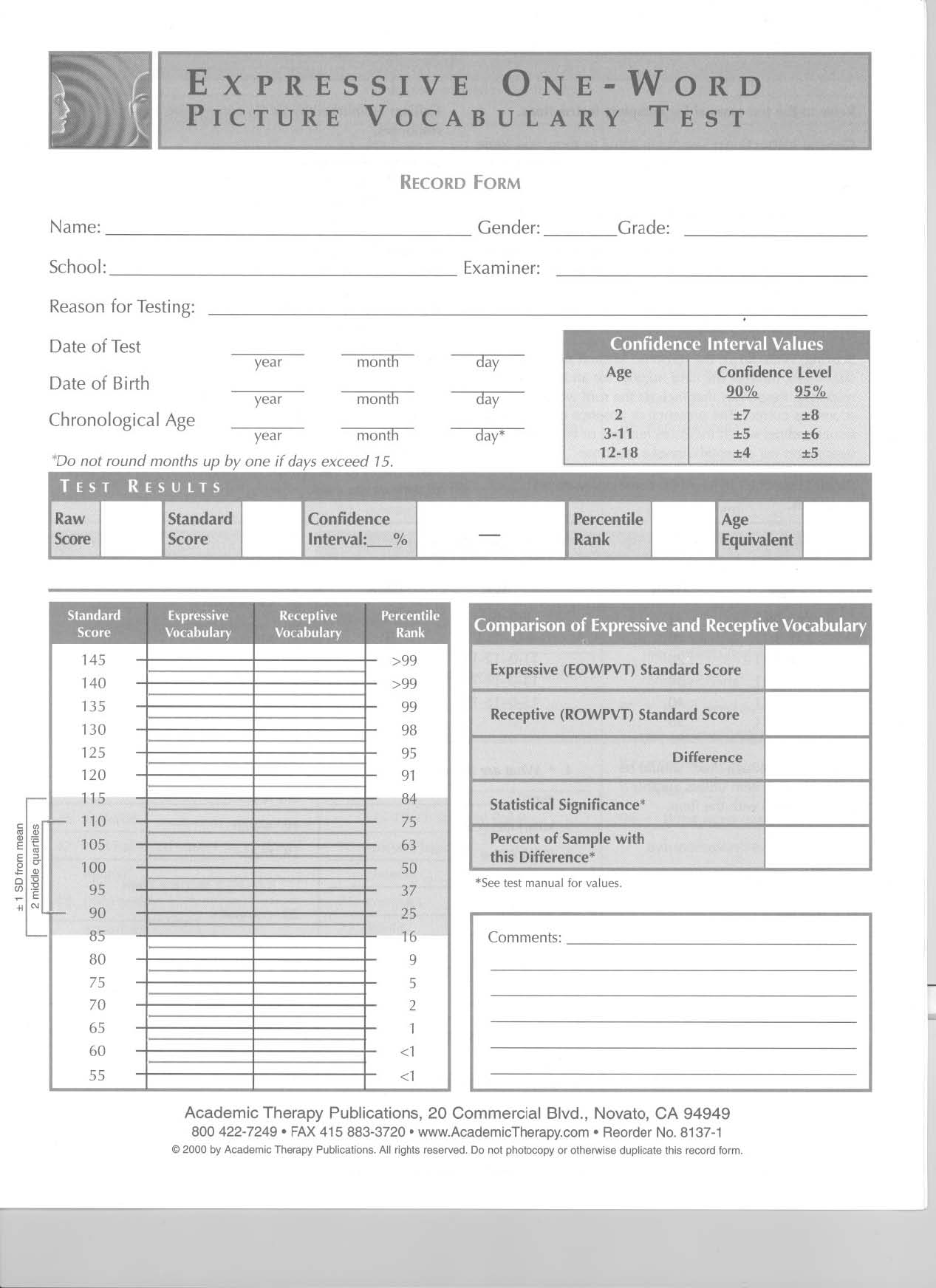
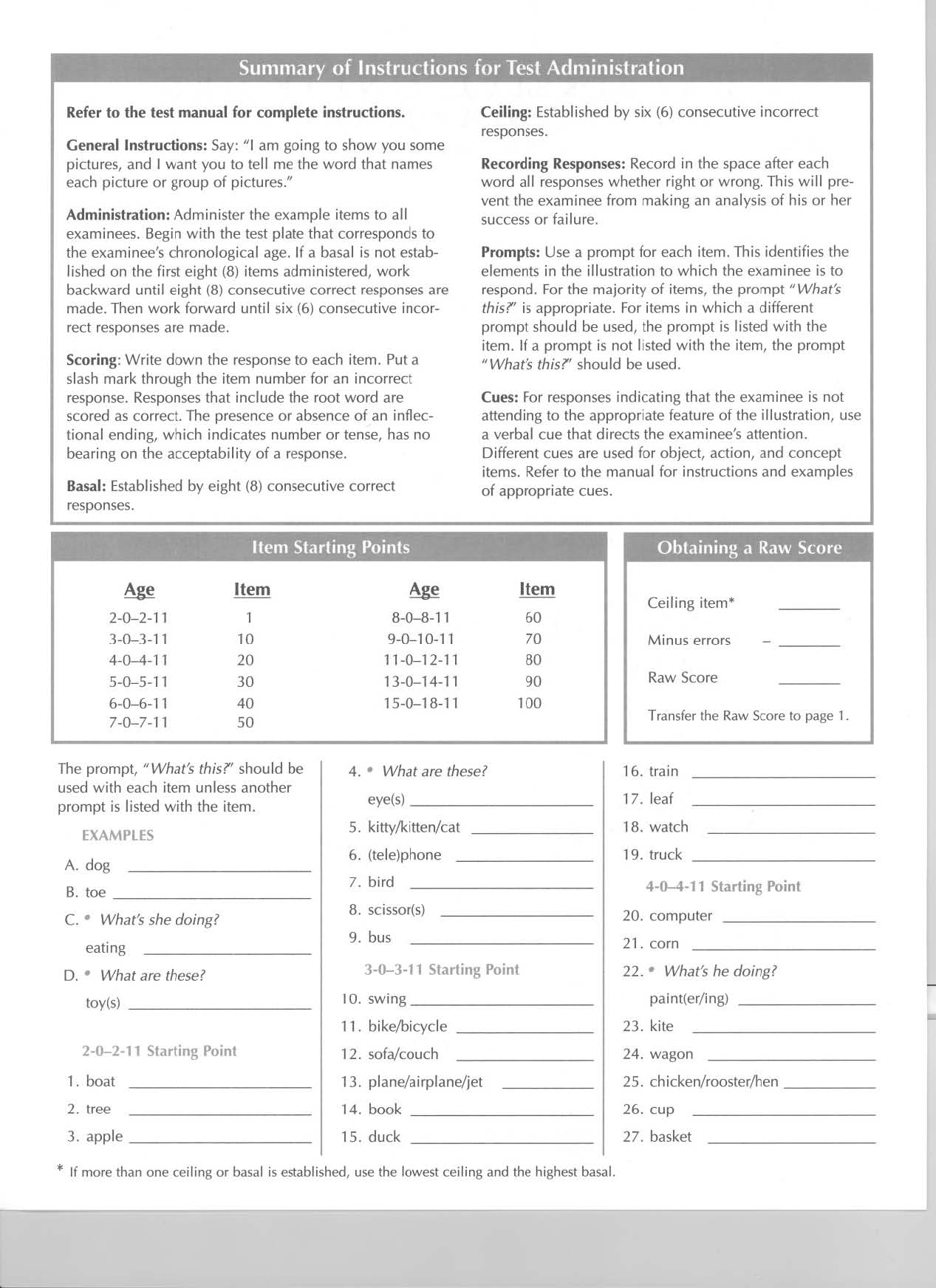
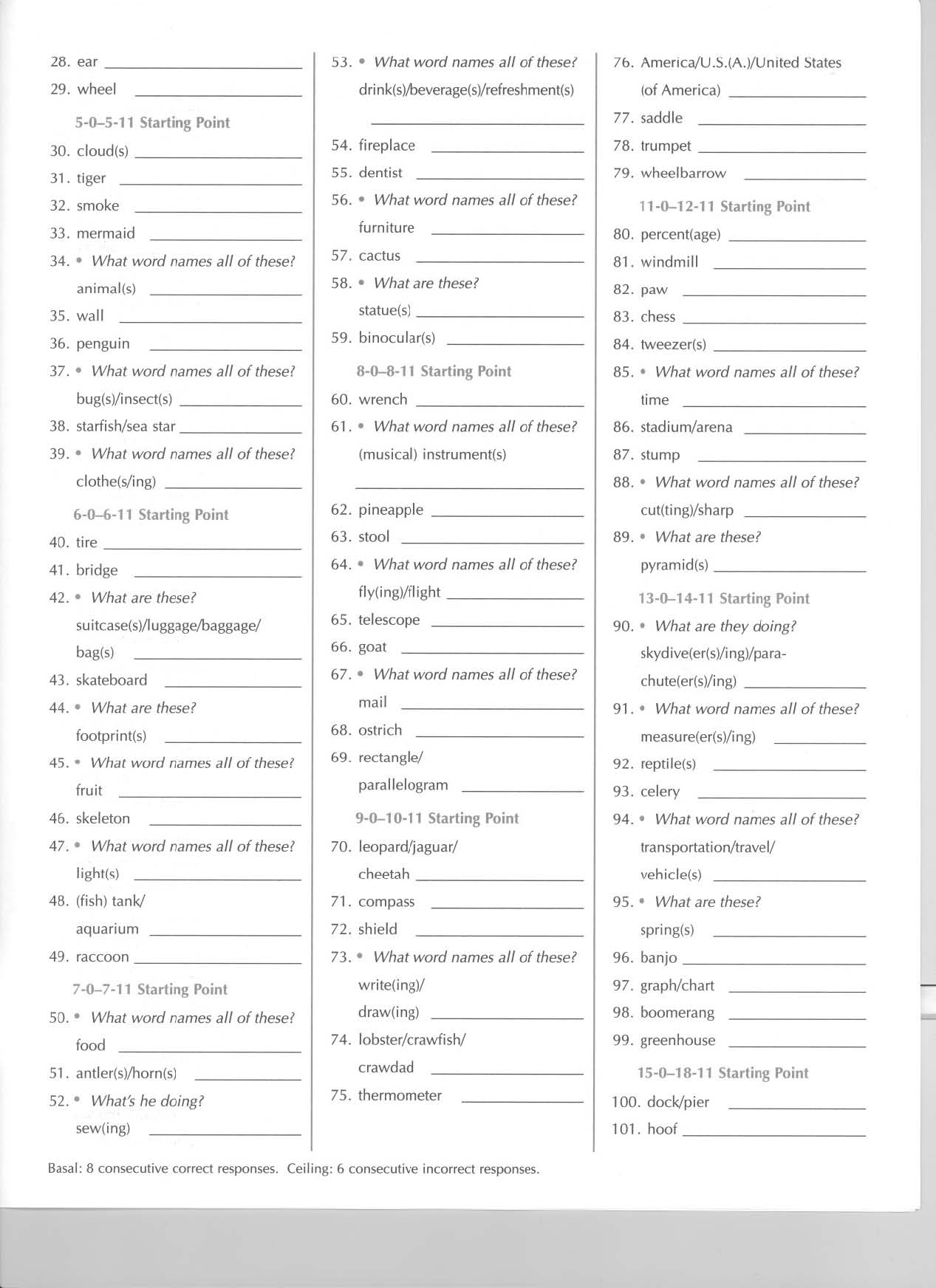
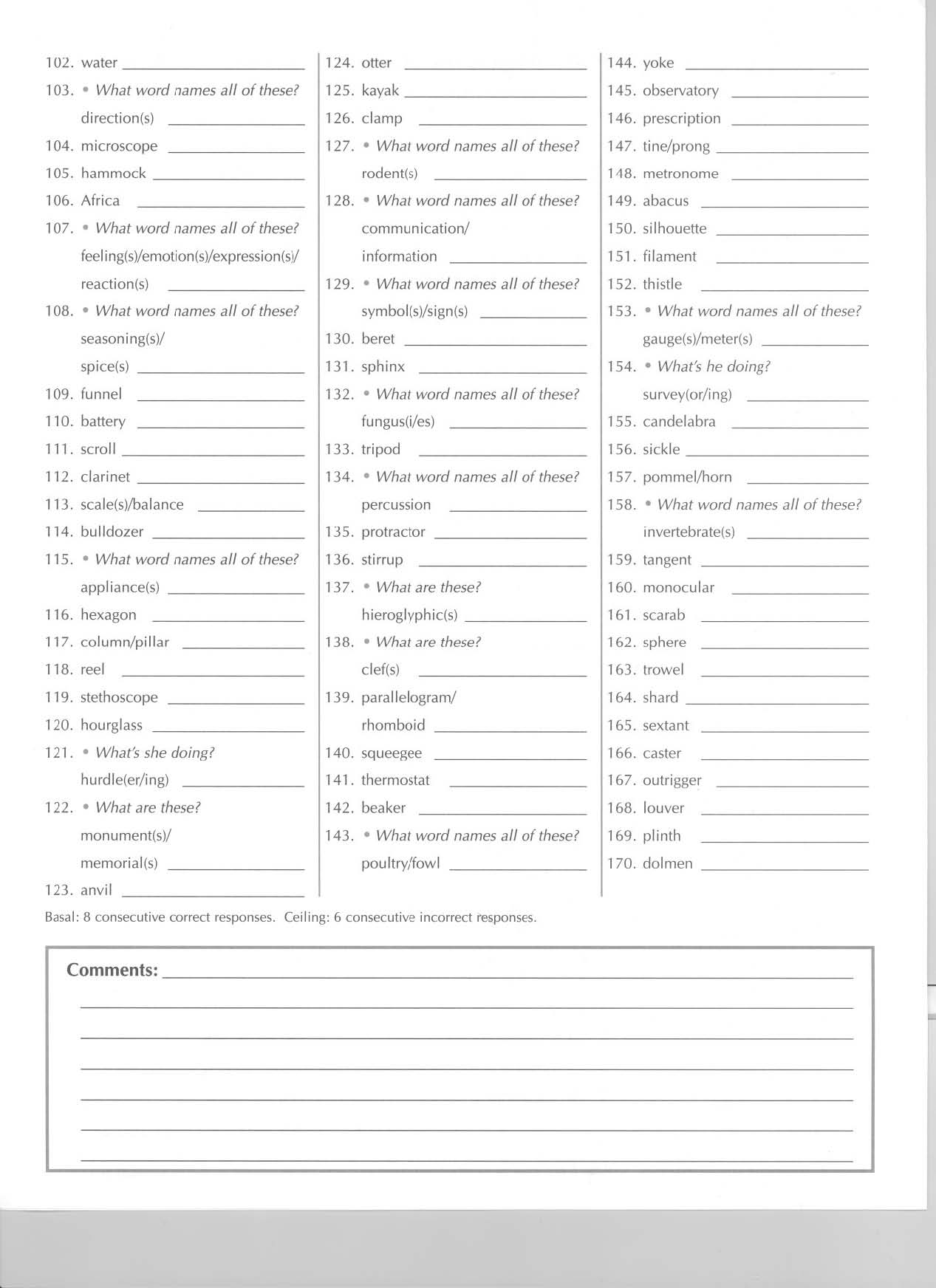
SECTION D: PENCIL TAPPING
D1. MAKE SURE THAT YOU HAVE TWO PENCILS
D2. Now for this game, when I tap my pencil one time (TAP ONE TIME), you tap your pencil two times (TAP TWO TIMES). And, when I tap my pencil two times (TAP TWO TIMES), you tap your pencil one time (TAP ONE TIME), ok?
D3a. Let’s try it. HAND ONE PENCIL TO CHILD.
ENTER CHILD’S RESPONSES TO PRACTICE TRIAL A
-
PRACTICE TRIAL
INTERVIEWER TAPS
CHILD
TAPS
A
1
72-73
USE RESPONSES BELOW TO PRAISE OR CORRECT CHILD AFTER PRACTICE TRIAL A.
IF CORRECT: Good!
IF INCORRECT: Almost, but that’s not quite right. When I tap one time (TAP ONE TIME), you should tap two times (TAP TWO TIMES). Let’s try again. I tap one time (TAP ONE TIME), so you tap… (PAUSE FOR CHILD TO TAP) two times.
IF CORRECT: Good!
IF INCORRECT: Like this. THEN, TAKE CHILD’S HAND AND TAP HIS/HER PENCIL TWO TIMES.
D
5-
-
PRACTICE TRIAL
INTERVIEWER TAPS
CHILD
TAPS
B
2
574-75
USE RESPONSES BELOW TO PRAISE OR CORRECT CHILD AFTER PRACTICE TRIAL B.
IF CORRECT: Good!
IF INCORRECT: Almost, but that’s not quite right. When I tap two times, you should tap one time. Let’s try again. I tap two times, so you tap… (PAUSE FOR CHILD TO TAP) one time.
IF CORRECT: Good!
IF INCORRECT: Like this. THEN, TAKE CHILD’S HAND AND TAP HIS/HER PENCIL ONE TIME.
D4. Ok, just to make sure you understand the rules of this game, tell me how they work.
WAIT FOR CHILD TO REPEAT RULES. IF CHILD DOES NOT UNDERSTAND, CORRECT THE CHILD BY REPEATING THE RULES.
IF CHILD CANNOT VERBALLY REPEAT THE RULES BACK, ASK:
Ok, what do you do if I tap my pencil one time (TAP ONE TIME)?
CHILD RESPONDS. IF CHILD IS INCORRECT, GIVE THE CORRECT ANSWER.
(REINFORCE TAPPING MOTION.)
What do you do if I tap my pencil two times (TAP TWO TIMES)?
CHILD RESPONDS. IF CHILD IS INCORRECT, GIVE THE CORRECT ANSWER.
(REINFORCE TAPPING MOTION.)
5-
D5. CHECKPOINT: CIRCLE CODE “1,” “2,” OR “3.”
576
1 CHILD IS NOT ABLE TO REPEAT RULES BACK
INTERVIEWER: END TASK, GO TO D7 AND MARK “NO.”
2 CHILD IS ABLE TO REPEAT RULES BACK
INTERVIEWER: CONTINUE WITH D6 ON NEXT PAGE.
3 NOT SURE IF CHILD UNDERSTANDS RULES
WHY? _____________________________________________ 77-78
___________________________________________________ 79-80
___________________________________________________ 81-82
INTERVIEWER: CONTINUE WITH D6 ON NEXT PAGE.
SKIP: 583-98
99-100:05
D
6-
NOTE:
ALWAYS RECORD “1” OR “2” IF THE CHILD TAPS ONE OR TWO TIMES.
IF THE CHILD TAPS MORE THAN TWO TIMES, RECORD “2+”.
IF IT IS UNCLEAR WHETHER THE CHILD TAPS ONE OR TWO TIMES, REPEAT THE TRIAL ONCE. IF STILL UNCLEAR, CHECK THE “NOT SURE” BOX.
Let’s begin.
-
TRIAL
INTERVIEWER TAPS
CHILD TAPS
C
2
611-12 [ ]
NOT SURE
13
D
1
14-15 [ ]
NOT SURE
16
E
1
17-18 [ ]
NOT SURE
19
F
2
20-21 [ ]
NOT SURE
22
G
1
23-24 [ ]
NOT SURE
25
H
2
26-27 [ ]
NOT SURE
28
I
1
29-30 [ ]
NOT SURE
31
J
2
32-33 [ ]
NOT SURE
34
SAY: You’re doing a great job! Let’s keep going!
K
2
35-36 [ ]
NOT SURE
37
L
1
38-39 [ ]
NOT SURE
40
M
2
41-42 [ ]
NOT SURE
43
N
1
44-45 [ ]
NOT SURE
46
O
1
47-48 [ ]
NOT SURE
49
P
2
50-51 [ ]
NOT SURE
52
Q
2
53-54 [ ]
NOT SURE
55
R
1
56-57 [ ]
NOT SURE
58
SKIP: 659-66
END: WHEN CHILD FINISHES, SAY: Great work! Now let’s play the next game.
D
6-
WERE YOU ABLE TO FULLY COMPLETE THIS TASK?
667
2 NO GO TO D8
D8. IF “NO” IN D7, WHAT PREVENTED YOU FROM COMPLETING TASK?
_
68-69
70-71
72-73
____________________________________________________
____________________________________________________
SECTION E: EMOTIONS AND CHALLENGING SITUATIONS TASK
E1. EMOTION TASK
TAKE OUT EMOTION TASKS EASEL
OPEN AND SET UP EASEL
START WITH THE FIRST PAGE UNDER THE TAB
BEGIN READING INSTRUCTIONS ON FIRST PAGE. START RECITING BOLD, NON-ITALIC WORDS. READ THE WORDS EXACTLY AS THEY ARE WRITTEN. USE INFLECTION IN YOUR VOICE.
NO
RESPONSE: GIVE THE CHILD ABOUT 5 SECONDS TO ANSWER.
|
Item # |
Emotion |
Correct Location |
Circle Child’s Response |
|
|
|
|
NA/DK/RF |
|
PRACTICE 1 |
Happy |
1 |
1 2 3 4 7 |
80 |
PRACTICE 2 |
Sad |
3 |
1 2 3 4 7 |
81 |
1 |
Happy |
4 |
1 2 3 4 7 |
82 |
2 |
Scared |
2 |
1 2 3 4 7 |
83 |
3 |
Sad |
3 |
1 2 3 4 7 |
84 |
RECORD
TIME _________ : _______ AM/PM
2140-43
44 4 |
Mad |
4 |
1 2 3 4 7 |
85 |
5 |
Scared |
4 |
1 2 3 4 7 |
86 |
6 |
Mad |
2 |
1 2 3 4 7 |
87 |
|
|
CONTINUE ON NEXT PAGE SKIP: 688-98 99-100:06 |
7-
Item # |
E
RECORD
TIME _________ : _______ AM/PM
2140-43
44 |
Correct Location |
Circle Child’s Response |
|
|
|
|
NA/DK/RF |
|
7 |
Happy |
3 |
1 2 3 4 7 |
711 |
8 |
Sad |
3 |
1 2 3 4 7 |
12 |
9 |
Mad |
1 |
1 2 3 4 7 |
13 |
10 |
Sad |
2 |
1 2 3 4 7 |
14 |
11 |
Scared |
1 |
1 2 3 4 7 |
15 |
12 |
Happy |
4 |
1 2 3 4 7 |
16 |
13 |
Sad |
1 |
1 2 3 4 7 |
17 |
14 |
Happy |
4 |
1 2 3 4 7 |
18 |
15 |
Mad |
3 |
1 2 3 4 7 |
19 |
16 |
Scared |
4 |
1 2 3 4 7 |
20 |
E3. INTERVIEWER:
WERE YOU ABLE TO FULLY COMPLETE THIS TASK?
21
1 YES GO TO E5
2 NO GO TO E4
E4. IF “NO” IN E3, WHAT PREVENTED YOU FROM COMPLETING TASK?
_
22-23
24-25
26-27
____________________________________________________
____________________________________________________
PUT EMOTION TASKS EASEL AWAY.
CONTINUE ON NEXT PAGE.
E5. CHALLENGING SITUATIONS TASK
INTRODUCE THE ACTIVITY AS FOLLOWS:
[CHILD’S NAME], what is your favorite toy?
I have some faces that show how kids can feel—the different feelings they can have.
This kid feels happy (PUT DOWN HAPPY FACE). This kid feels sad (PUT DOWN SAD FACE). This kid feels mad (PUT DOWN MAD FACE). This kid feels scared (PUT DOWN SCARED FACE).
E5a.
Which one would you feel like if you got a brand new (INSERT CHILD’S FAVORITE TOY)?
POINT TO EACH FACE WHILE ASKING:
Would you feel happy, sad, mad, or scared? (CIRCLE THE EMOTION CHILD CHOSE)
IF CHILD ANSWERS “HAPPY”: Great!
IF CHILD DOES NOT SAY “HAPPY”: Yeah, you’d feel (INSERT EMOTION CHILD CHOSE). Some kids would feel happy. Have you ever felt happy? Great! Okay.
E5b.
Which one would you feel like if you lost your (INSERT CHILD’S FAVORITE TOY)?
POINT TO EACH FACE WHILE ASKING:
Would you feel happy, sad, mad, or scared? (CIRCLE THE EMOTION CHILD CHOSE)
IF CHILD ANSWERS “SAD”: Okay.
IF CHILD DOES NOT SAY “SAD”: Yeah, you’d feel (INSERT EMOTION CHILD CHOSE). Some kids would feel sad. Have you ever felt sad? Okay.
E5c.
Which one would you feel like if someone smashed your new (INSERT CHILD’S FAVORITE TOY) and broke it?
POINT TO EACH FACE WHILE ASKING:
Would you feel happy, sad, mad, or scared? (CIRCLE THE EMOTION CHILD CHOSE)
IF CHILD ANSWERS “MAD”: Okay.
IF CHILD DOES NOT SAY “MAD”: Yeah, you’d feel (INSERT EMOTION CHILD CHOSE). Some kids would feel mad. Have you ever felt mad? Okay.
E5d.
Which one would you feel like if a big mean-looking dog was barking at you?
POINT TO EACH FACE WHILE ASKING:
Would you feel happy, sad, mad, or scared? (CIRCLE THE EMOTION CHILD CHOSE)
IF CHILD ANSWERS “SCARED”: Okay.
IF CHILD DOES NOT SAY “SCARED”: Yeah, you’d feel (INSERT EMOTION CHILD CHOSE). Some kids would feel scared. Have you ever felt scared? Okay.
PULL OUT PICTURES OF SITUATIONS, PICTURE OF EMOTIONS, AND PICTURES OF BEHAVIORAL RESPONSES, MATCHED TO THE FOCAL CHILD’S GENDER.
E6. SITUATION 1
SHOW PICTURE OF SITUATION 1.
Now we are going to play a pretend game. I am going to tell you some stories. I’d like you to pretend that these stories really happened to you.
IF THE CHILD IS A GIRL: I’m going to show you some pictures for the story and I want for you to pretend that you are the child with the red shirt. Her name is Jane.
IF THE CHILD IS A BOY: I’m going to show you some pictures for the story and I want for you to pretend that you are the child with the blue shirt. His name is John.
E
7-
(John/Jane) was building a very tall tower of blocks (POINT TO JOHN/JANE). Bobby knocked it down (POINT TO BOBBY, CHILD IN PLAIN SHIRT). If someone knocked your tower down, how would you feel?
LAY OUT EMOTIONS, ONE BY ONE, LABELING EACH AS YOU SET IT DOWN. CIRCLE CHILD’S RESPONSE.
Would you feel…
728
Happy (PAUSE)
Sad (PAUSE)
Mad (PAUSE), or
Scared?
NO RESPONSE
INTERVIEWER: 29 E6a1. CHECK BOX if child provided a mismatching verbal and pointed response: □ E6a2. If checked, what was child’s verbal response? ________________________________________
|
30-31
REMOVE EMOTION FACES.
E6b.
I am going to show you some pictures. I want you to choose the one you would do if someone knocked down your tower of blocks? Wait until I put all the pictures down before you pick one.
LAY OUT EACH PICTURE, ONE BY ONE, LABELING EACH AS YOU SET IT DOWN. CIRCLE CHILD’S RESPONSE.
Would you… 32
Tell Bobby, “Let’s fix it” (PAUSE)
Hit Bobby or yell at (him/her) (PAUSE)
Go tell on Bobby (PAUSE), or
Find something else to do?
NO RESPONSE
OTHER RESPONSE
(SPECIFY: ______________________________________________________)
33-34
REMOVE ALL PICTURES.
E
7-
SHOW PICTURE OF SITUATION 2.
E7a.
(John/Jane) is having a good time playing in the sandbox (POINT TO JOHN/JANE). Bobby hits (him/her) (POINT TO BOBBY, CHILD IN PLAIN SHIRT). If someone hit you, how would you feel?
LAY OUT EMOTIONS, ONE BY ONE, LABELING EACH AS YOU SET IT DOWN. CIRCLE CHILD’S RESPONSE.
Would you feel…
735
Happy (PAUSE)
Sad (PAUSE)
Mad (PAUSE), or
Scared?
NO RESPONSE
INTERVIEWER: 36 E7a1. CHECK BOX if child provided a mismatching verbal and pointed response: □ E7a2. If checked, what was child’s verbal response? ____________________________________
|
37-38
REMOVE EMOTION FACES.
E7b.
I am going to show you some pictures. I want you to choose the one you would do if someone hit you? Wait until I put all the pictures down before you pick one.
LAY OUT EACH PICTURE, ONE BY ONE, LABELING EACH AS YOU SET IT DOWN. CIRCLE CHILD’S RESPONSE.
Would you… 39
Hit (him/her)back (PAUSE)
Tell the teacher (PAUSE)
Play somewhere else (PAUSE), or
Tell (him/her), “That’s not nice?”
NO RESPONSE
OTHER RESPONSE
(SPECIFY: ______________________________________________________)
40-41
REMOVE ALL PICTURES.
E
7-
SHOW PICTURE OF SITUATION 3.
E8a.
(John/Jane) (POINT TO JOHN/JANE) saw Bobby (POINT TO BOBBY, CHILD IN PLAIN SHIRT) building a castle with Legos. (He/she) wanted to build too. (He/she) asked Bobby, “Can I play too?” Bobby said, “No! I don’t want you to play here.” If you wanted to play Legos with another kid and (he/she) wouldn’t let you, how would you feel?
LAY OUT EMOTIONS, ONE BY ONE, LABELING EACH AS YOU SET IT DOWN. CIRCLE CHILD’S RESPONSE.
Would you feel…
742
Happy (PAUSE)
Sad (PAUSE)
Mad (PAUSE), or
Scared?
NO RESPONSE
INTERVIEWER: 43 E8a1. CHECK BOX if child provided a mismatching verbal and pointed response: □ E8a2. If checked, what was child’s verbal response? ____________________________________
|
44-45
REMOVE EMOTION FACES.
E8b.
I am going to show you some pictures. I want you to choose the one you would do if you wanted to play Legos and someone said, “No”? Wait until I put all the pictures down before you pick one.
LAY OUT EACH PICTURE, ONE BY ONE, LABELING EACH AS YOU SET IT DOWN. CIRCLE CHILD’S RESPONSE.
Would you…
46
Ask if you could use some of the Legos to build something else (PAUSE)
Grab a bunch of Legos so you could build your own castle (PAUSE)
Go tell the teacher (he/she) wouldn’t share (PAUSE), or
Go play with something else?
NO RESPONSE
OTHER RESPONSE (SPECIFY: ___________________________________________________)
47-48
REMOVE ALL PICTURES.
7-
E9. SITUATION 4
SHOW PICTURE OF SITUATION 4.
E9a.
(John/Jane) (POINT TO JOHN/JANE) was kicking a soccer ball. Bobby (POINT TO BOBBY, CHILD IN PLAIN SHIRT) came and took the soccer ball. How would you feel if someone took your ball when you were kicking it?
LAY OUT EMOTIONS, ONE BY ONE, LABELING EACH AS YOU SET IT DOWN. CIRCLE CHILD’S RESPONSE.
Would you feel…
749
Happy (PAUSE)
Sad (PAUSE)
Mad (PAUSE), or
Scared?
NO RESPONSE
INTERVIEWER: 50 E9a1. CHECK BOX if child provided a mismatching verbal and pointed response: □ E9a2. If checked, what was child’s verbal response? ____________________________________
|
51-52
SKIP: 753-60
REMOVE EMOTION FACES.
E9b.
I am going to show you some pictures. I want you to choose the one you would do if someone took your ball? Wait until I put all the pictures down before you pick one.
LAY OUT EACH PICTURE, ONE BY ONE, LABELING EACH AS YOU SET IT DOWN. CIRCLE CHILD’S RESPONSE.
Would you…
61
Go play something else (PAUSE)
Say, “Let’s play soccer together” (PAUSE)
Grab the ball back (PAUSE), or
Say, “I’m going to tell on you?”
NO RESPONSE
OTHER RESPONSE
(SPECIFY: _____________________________________________________)
62-63
REMOVE ALL PICTURES.
END: WHEN CHILD FINISHES, SAY: Alright! We’re all done playing with this game! Let’s go on to the next one!
E
7-
WERE YOU ABLE TO FULLY COMPLETE THIS TASK?
764
2 NO GO TO E11
E11. IF “NO” IN E10, WHAT PREVENTED YOU FROM COMPLETING TASK?
_
65-66
67-68
69-70
____________________________________________________
____________________________________________________
SECTION F: HEAD-TO-TOES TASK
The Head-to-Toes Task will be used as a direct assessment of behavioral regulation. This task requires three skills: inhibitory control, attention, and working memory. Children will be asked to play a game in which they are instructed to do the opposite of what the experimenter says. For example, the experimenter will instruct them to touch their head (or their toes), and instead of following the command, children will be directed to do the opposite and touch their toes (head). After two questions to check understanding, children will be given four practice tests and the instructions will be repeated up to three times during the practice tests. After the practice tests are administered, the testing portion of the task will be given. During the testing portion, the experimenter will state the behavioral commands without modeling any actions.
There are a total of 10 items in random order, with possible item scores of 0, 1, or 2 for each item. Higher scores indicate higher levels of behavioral regulation. A 0 is incorrect, 1 is a self-correct (defined as any motion toward the incorrect response but where the child then stops and responds correctly), and 2 points are given if a child gives the correct response without hesitation or a prior movement to the incorrect response. The sum of scores for the 10 items will be computed and possible scores ranged from 0 to 20.
Section G: Item Selection
(“Something’s the Same Game”)
In this game, we are going to look at more pictures and find things
about them that are the same in some way.
5
Item Selection
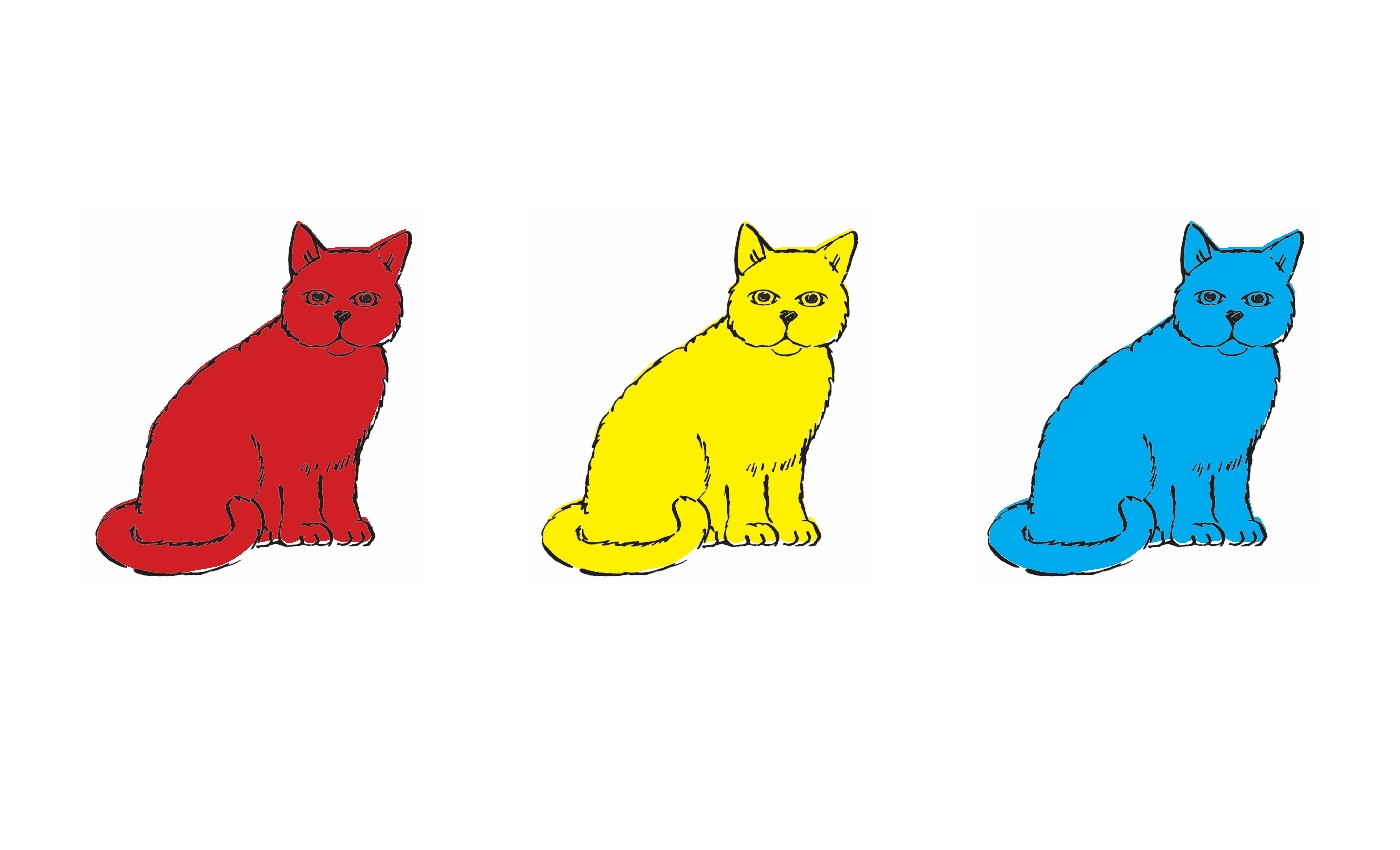 6
6
Item Selection
Practice Card: Color Dimension
First, please . . .
Show me the red cat.
Show me the blue cat.
Show me the yellow cat.
7
Item Selection
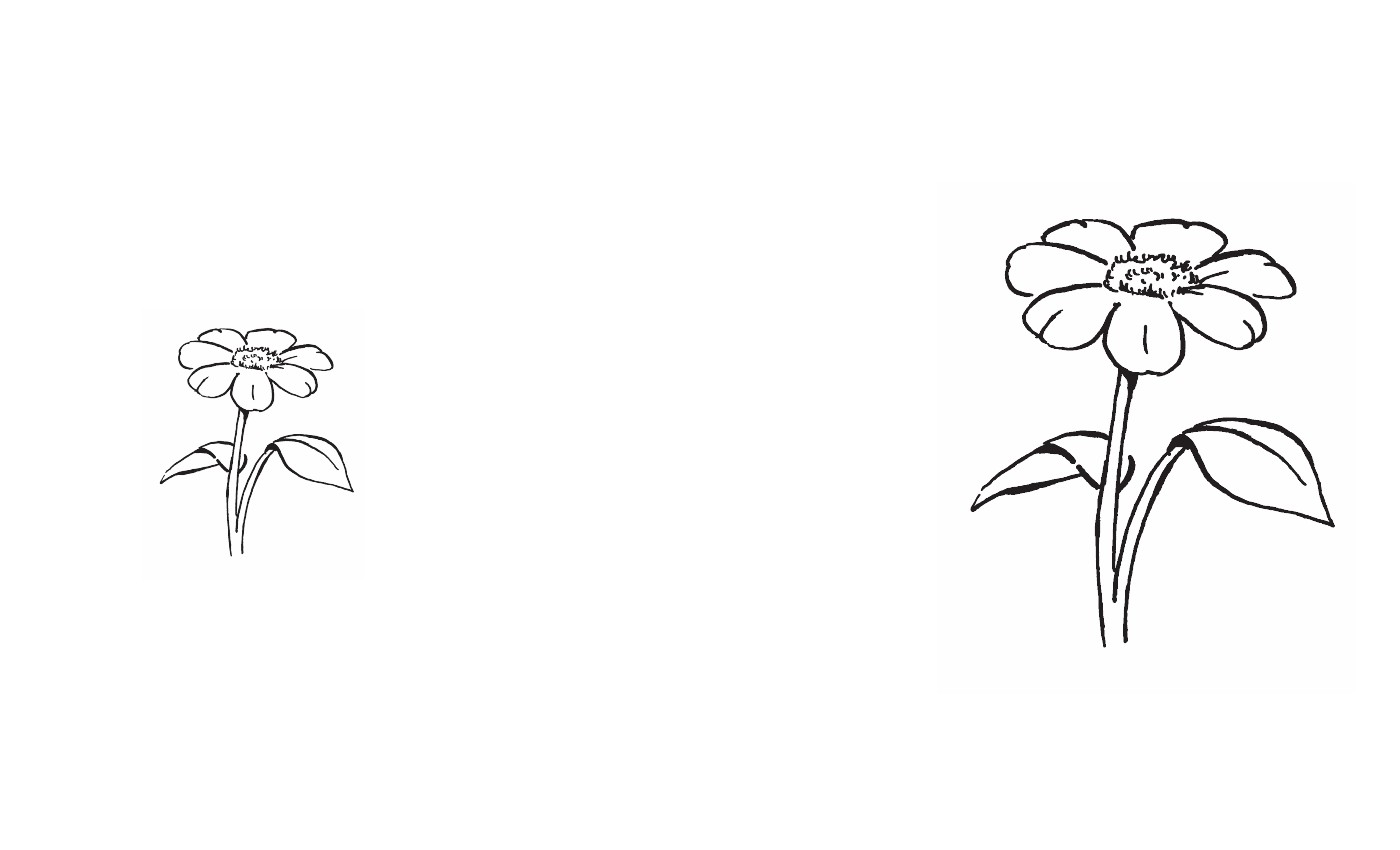 8
8
Item Selection
Practice Card: Size Dimension
Now, please . . .
Show me the big flower.
Show me the little flower.
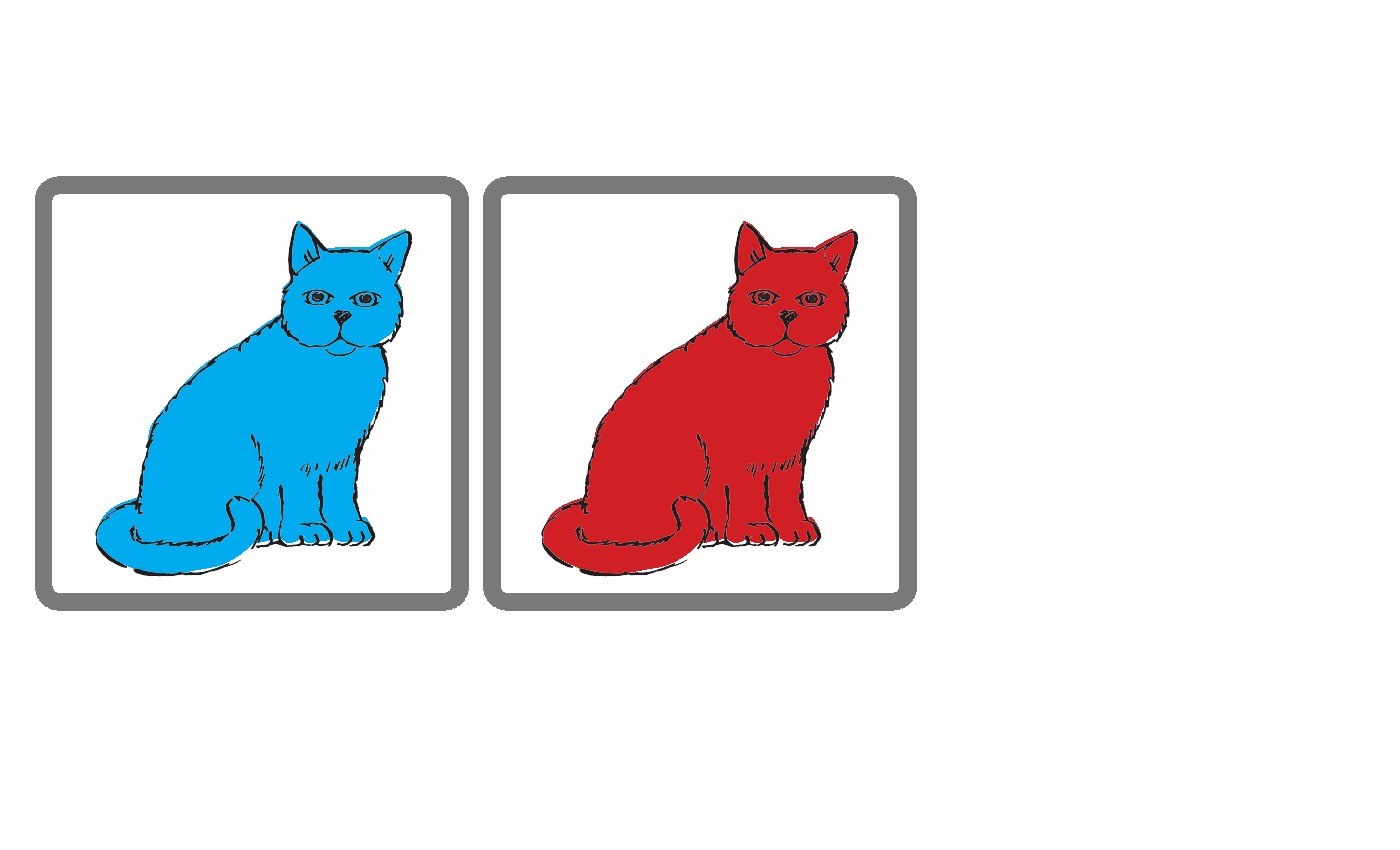 10
10
Item Selection
Dimension: cat
Here are two pictures. Something’s the same. They are both cats.
[Cue partner to begin recording child’s
response.]
11
Item Selection
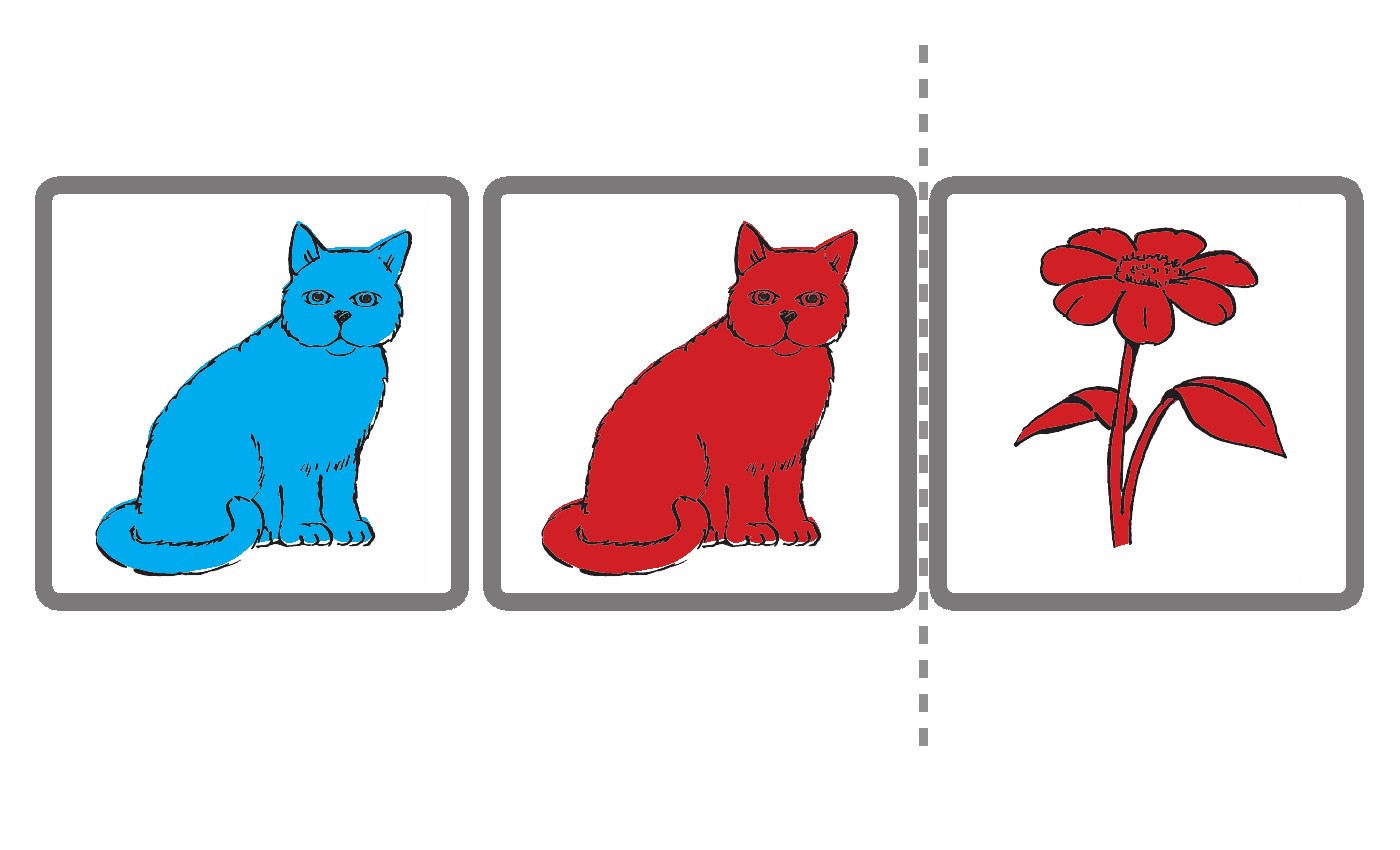 Item
1
Item
1
12
Item Selection
 Item
1
Item
1
Here is another picture. Which of these pictures . . .
[Point to first two pictures.]
. . . is the same as this one?
[Point to the flower.]
[If the child does not choose the red cat, say:]
The red cat is the same as this new picture because they
are both red.
[You may repeat these directions up to two
times. ]
13
Item Selection
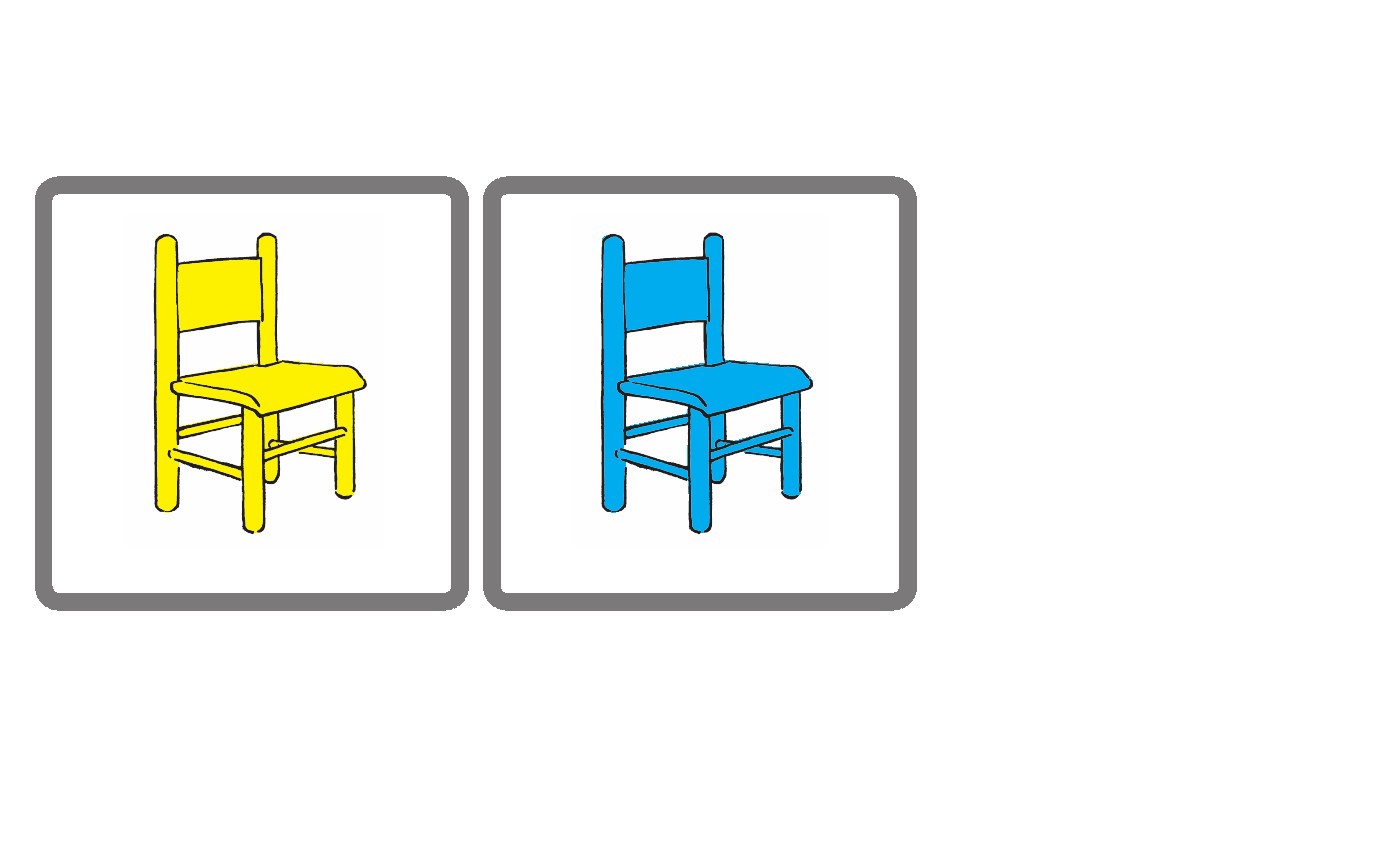 14
14
Item Selection
Dimension: chair
Here are two pictures. Something’s the same. They are both chairs.
15
Item Selection
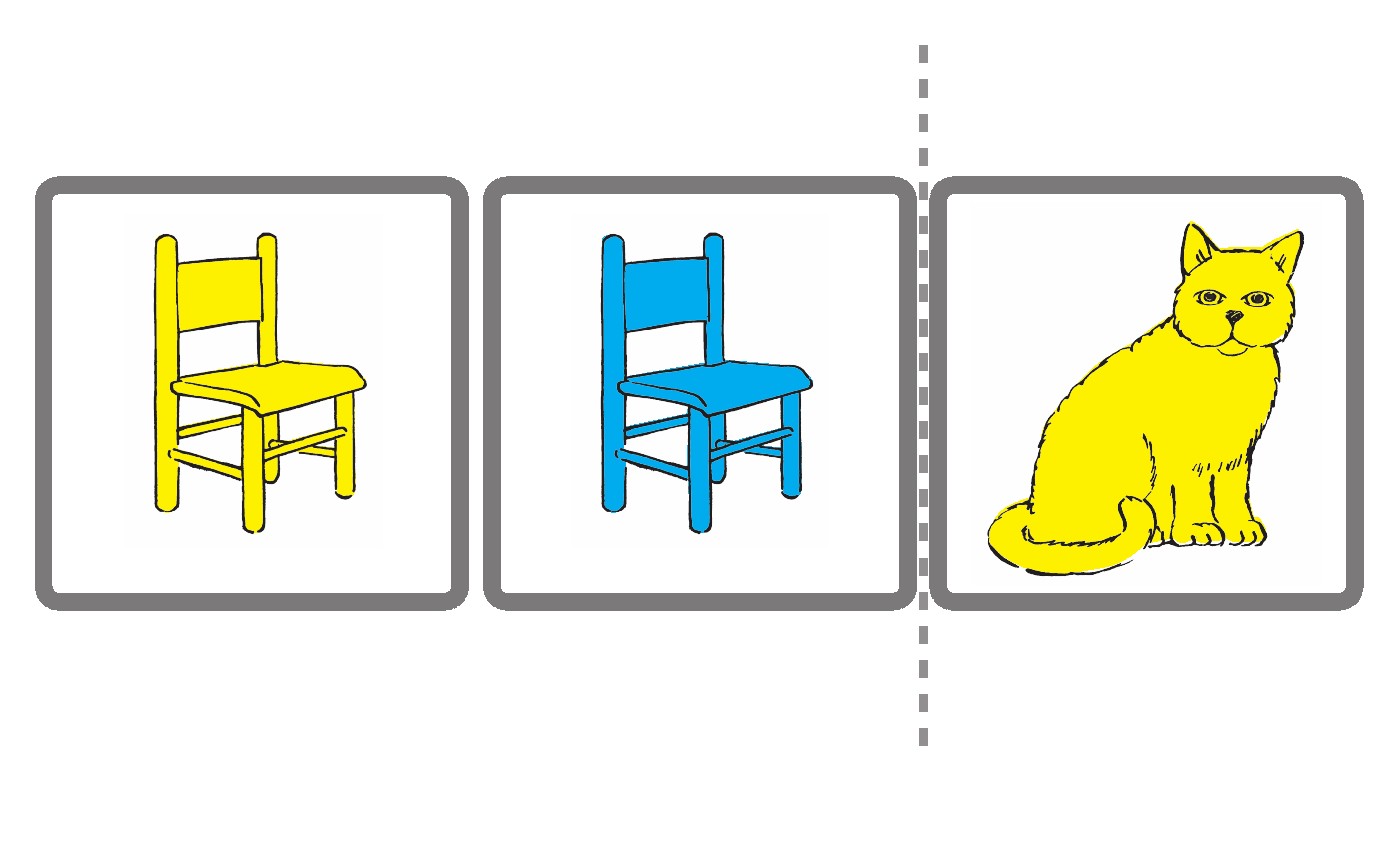 Item
2
Item
2
16
Item Selection
 Item
2
Item
2
Here is another picture. Which of these pictures . . .
[Point to first two pictures.]
. . . is the same as this one?
[Point to the cat.]
17
Item Selection
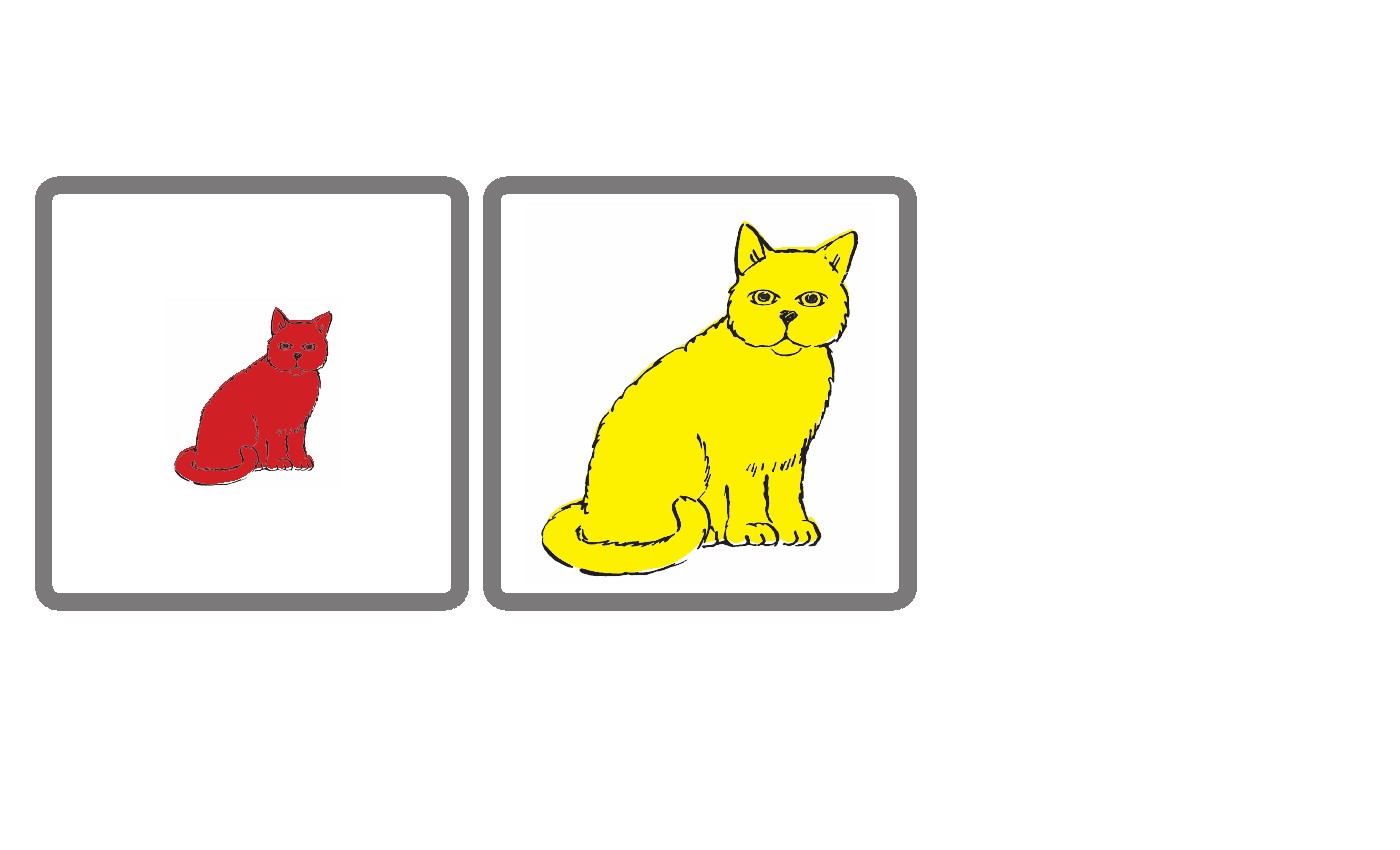 18
18
Item Selection
Dimension: cat
Here are two pictures. Something’s the same. They are both cats.
19
Item Selection
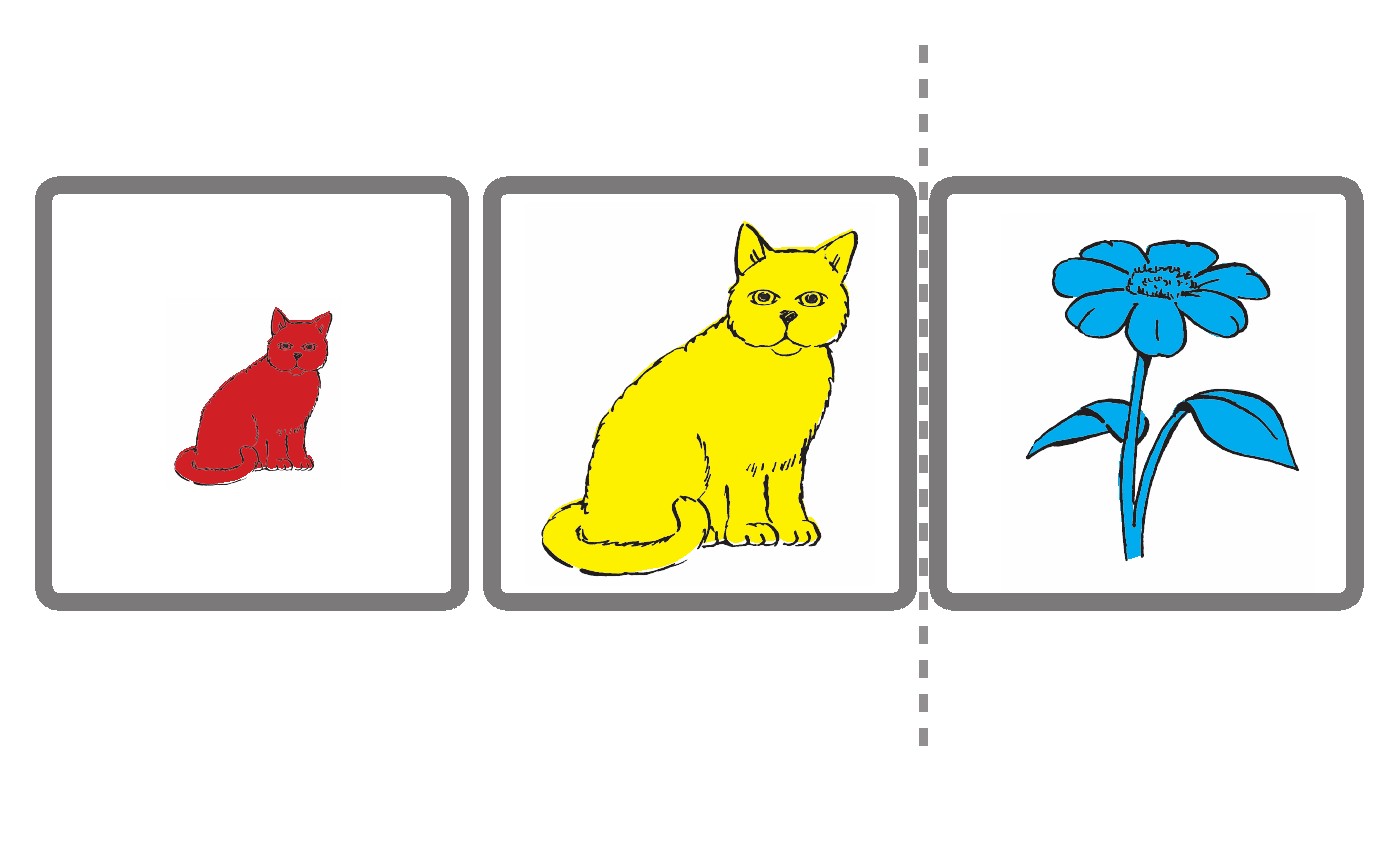 Item
3
Item
3
20
Item Selection
 Item
3
Item
3
Here is another picture. Which of these pictures . . .
[Point to first two pictures.]
. . . is the same as this one?
[Point to the big blue flower.]
21
Item Selection
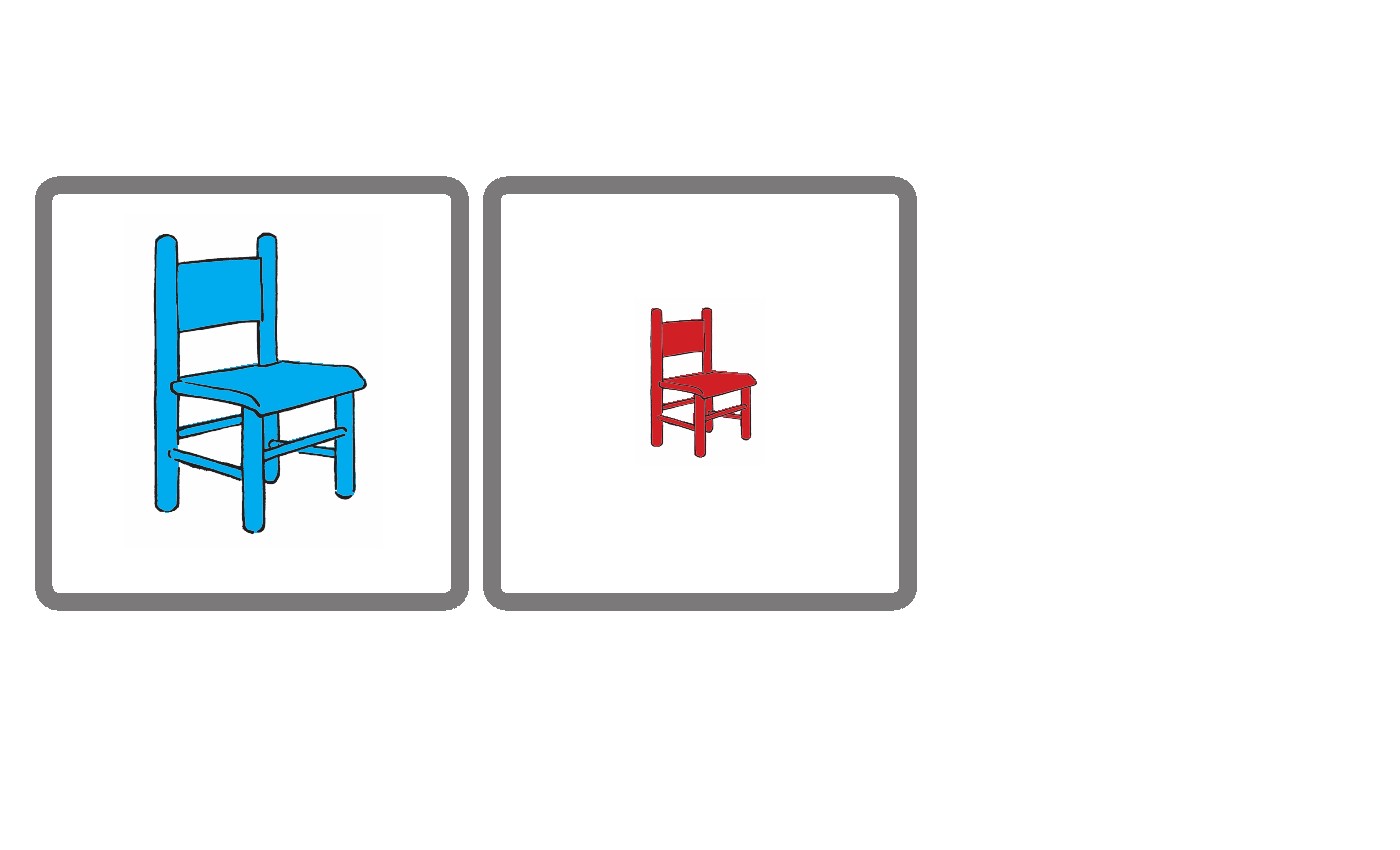 22
22
Item Selection
Dimension: chair
Here are two pictures. Something’s the same. They are both chairs.
23
Item Selection
 Item
4
Item
4
24
Item Selection
 Item
4
Item
4
Here is another picture. Which of these pictures . . .
[Point to first two pictures.]
. . . is the same as this one?
[Point to the small yellow flower.]
25
Item Selection
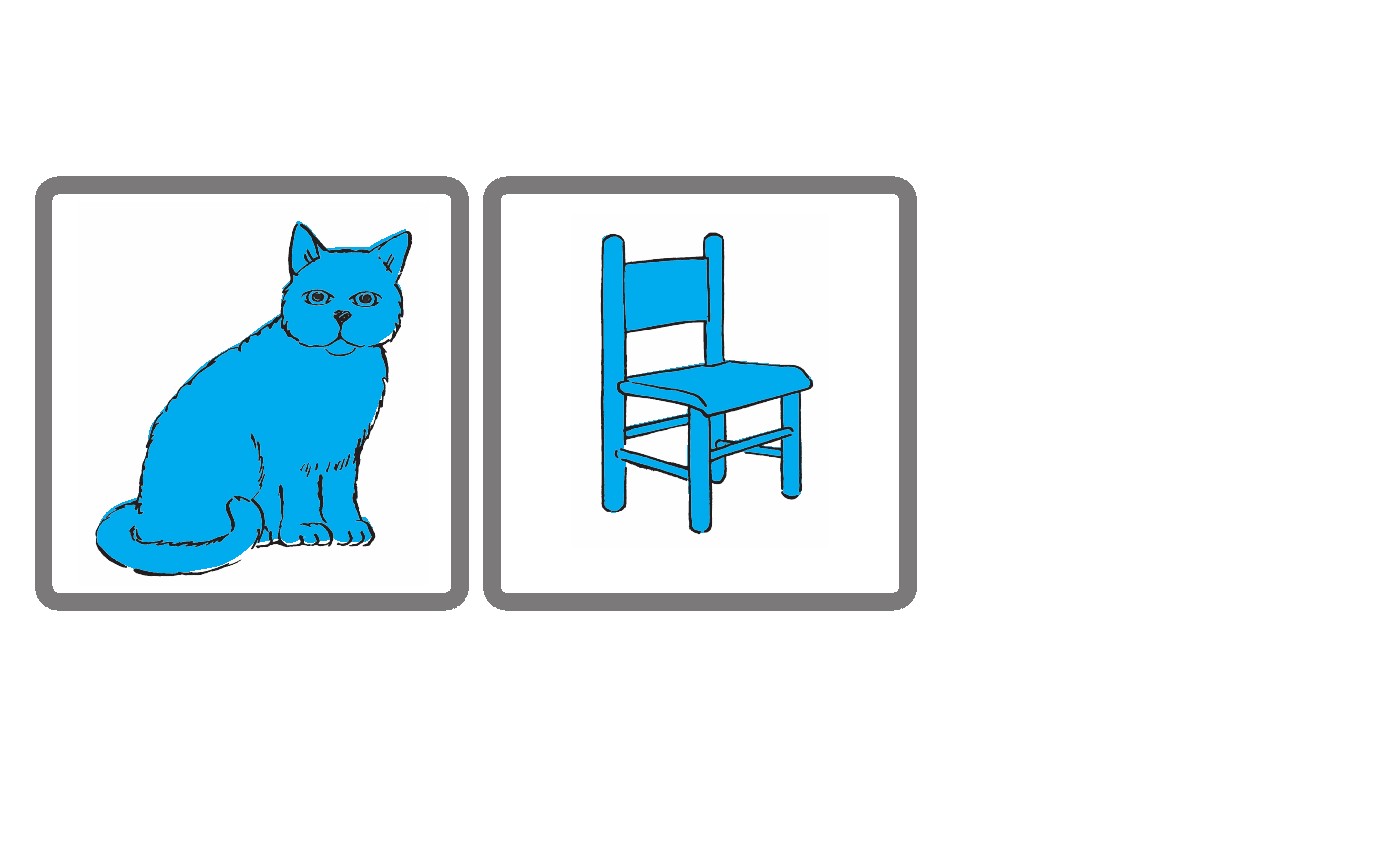 26
26
Item Selection
Dimension: blue
Here are two pictures. Something’s the same. They’re both blue.
27
Item Selection
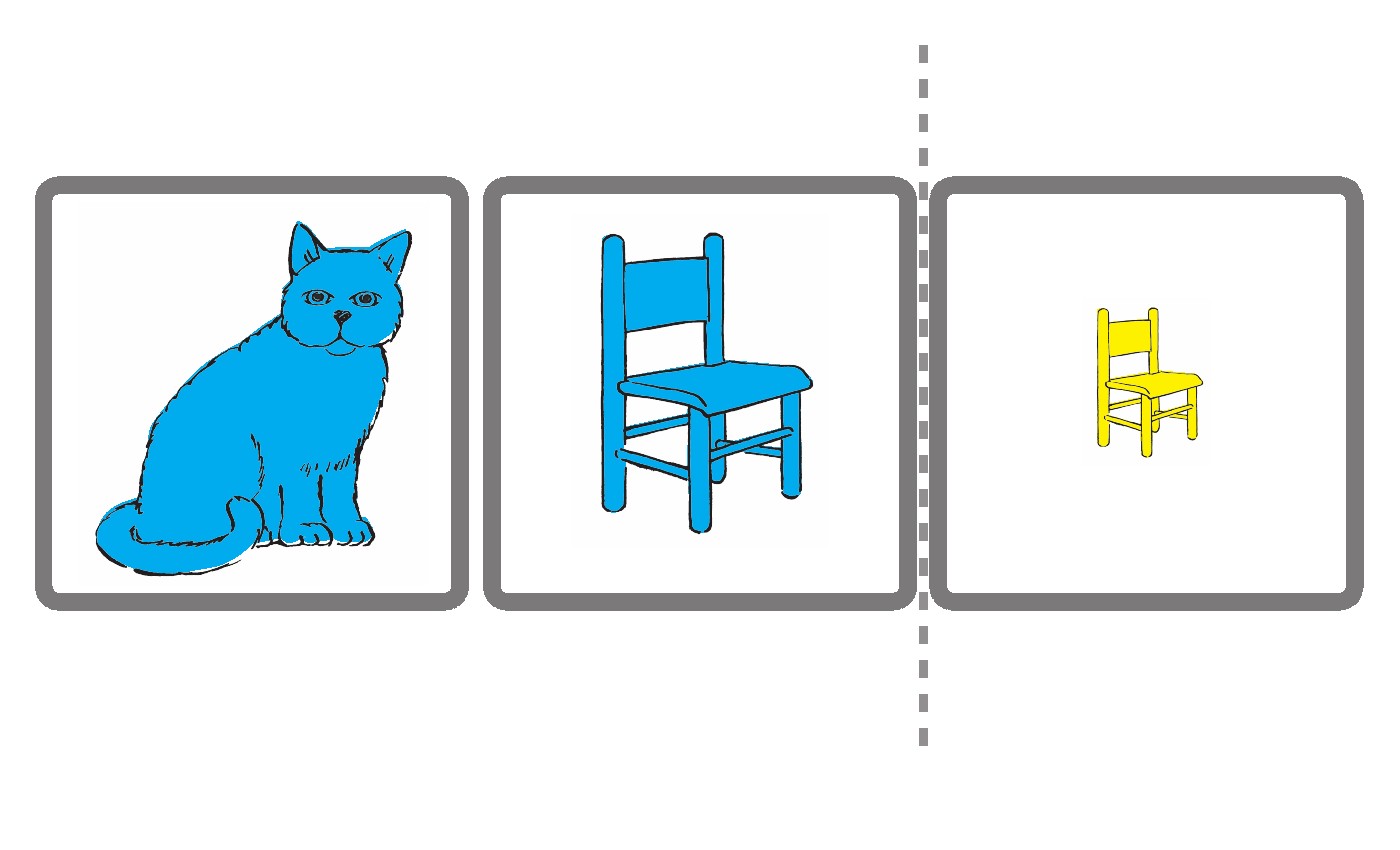 Item
5
Item
5
28
Item Selection
 Item
5
Item
5
Here is another picture. Which of these pictures . . .
[Point to first two pictures.]
. . . is the same as this one?
[Point to the small yellow chair.]
29
Item Selection
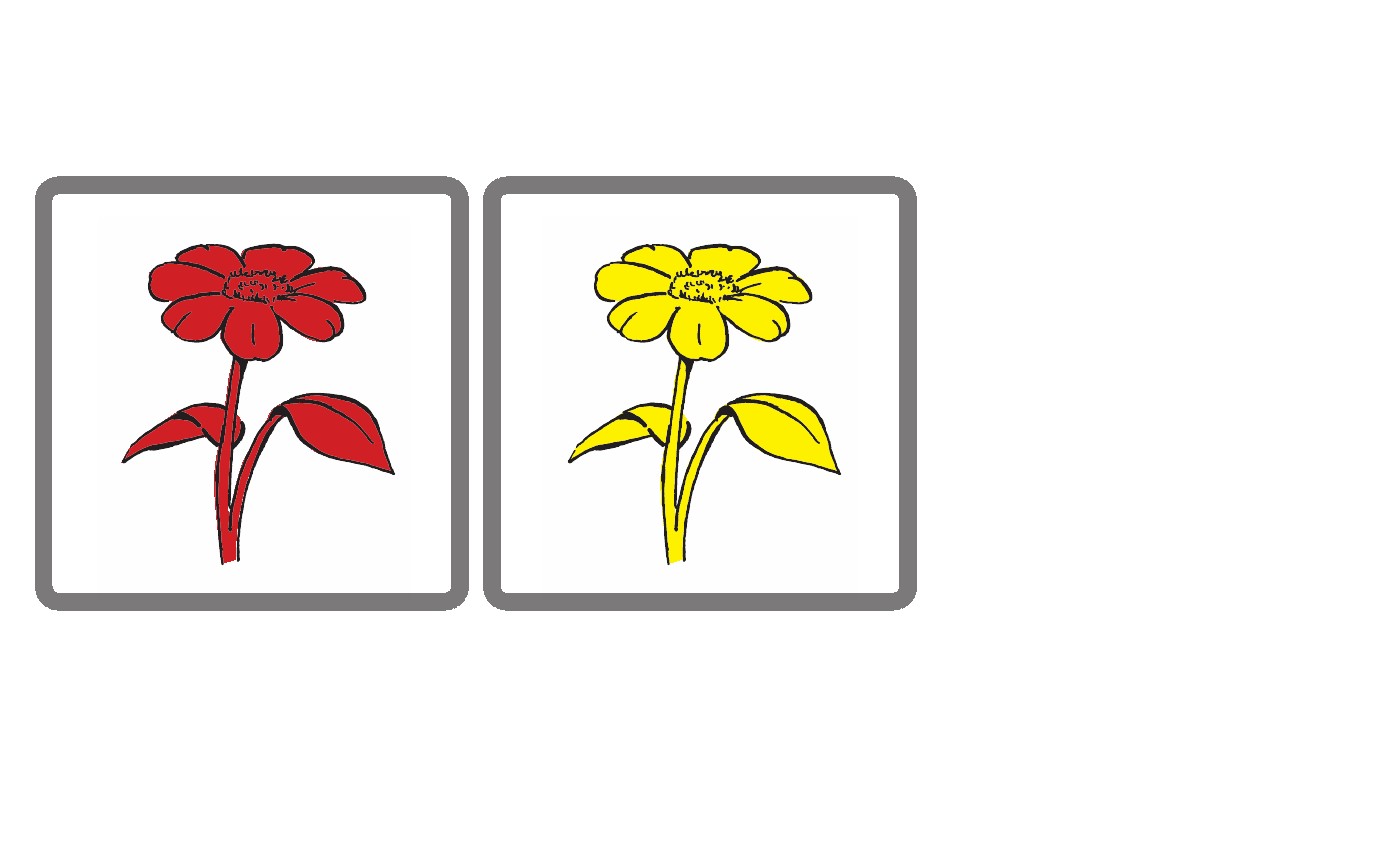 30
30
Item Selection
Dimension: flower
Here are two pictures. Something’s the same. They are both
flowers.
31
Item Selection
 Item
6
Item
6
32
Item Selection
 Item
6
Item
6
Here is another picture. Which of these pictures . . .
[Point to first two pictures.]
. . . is the same as this one?
[Point to the cat.]
33
Item Selection
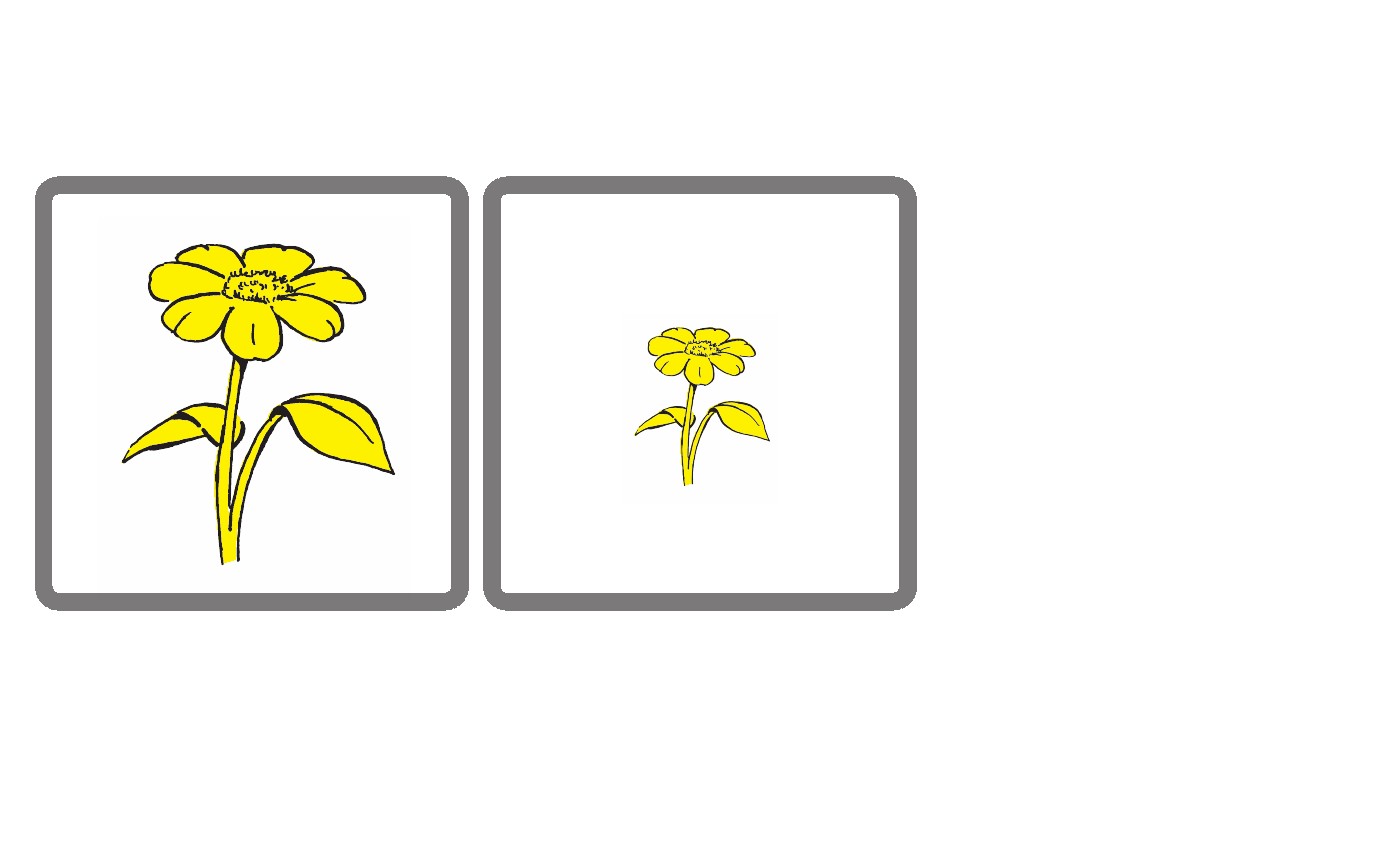 34
34
Item Selection
Dimension: flower
Here are two pictures. Something’s the same. They’re both flowers.
35
Item Selection
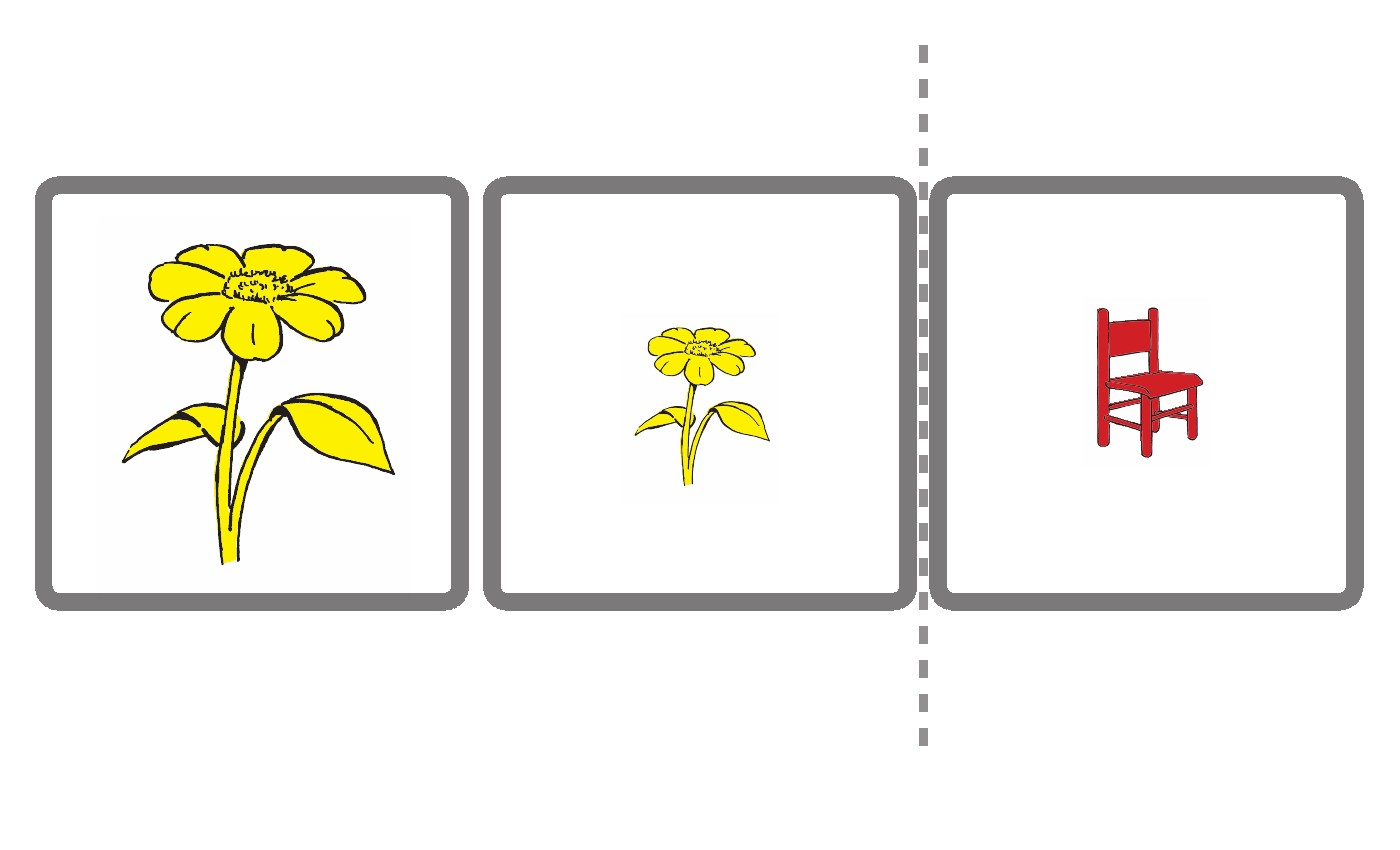 Item
7
Item
7
36
Item Selection
 Item
7
Item
7
Here is another picture. Which of these pictures . . .
[Point to first two pictures.]
. . . is the same as this one?
[Point to the small red chair.]
37
Item Selection
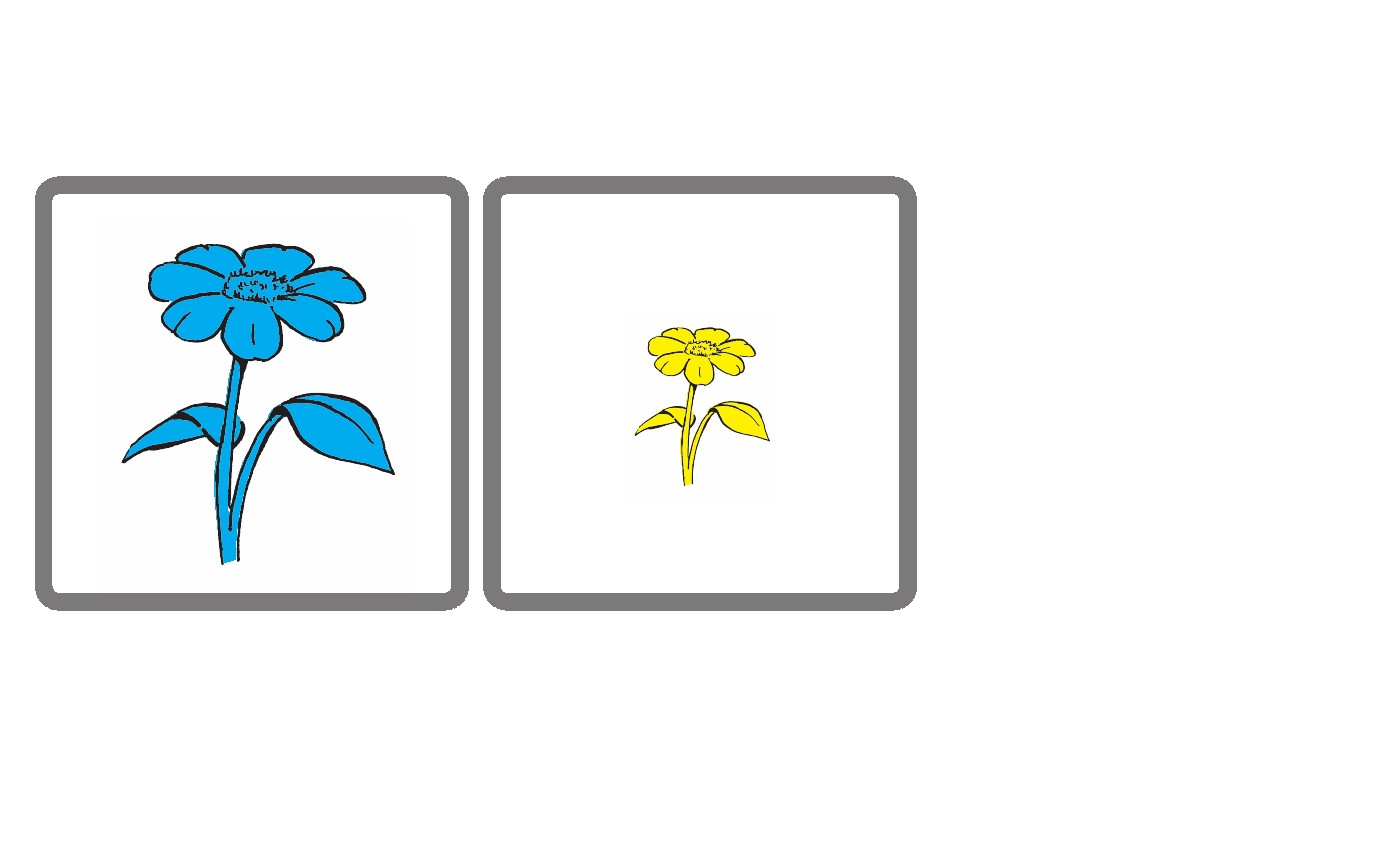 38
38
Item Selection
Dimension: flower
Here are two pictures. Something’s the same. They are both
flowers.
39
Item Selection
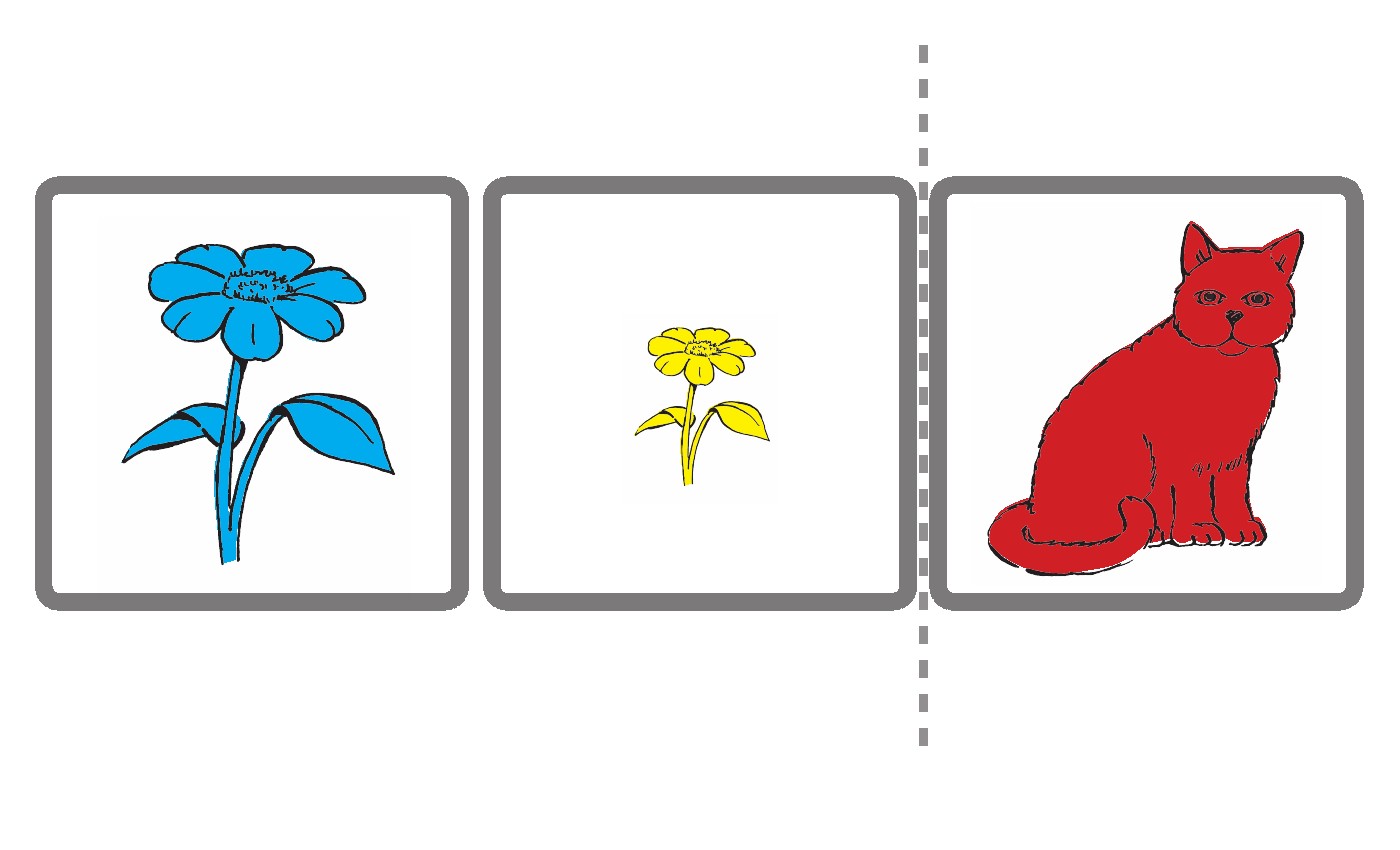 Item
8
Item
8
40
Item Selection
 Item
8
Item
8
Here is another picture. Which of these pictures . . .
[Point to first two pictures.]
. . . is the same as this one?
[Point to the big red cat.]
41
Item Selection
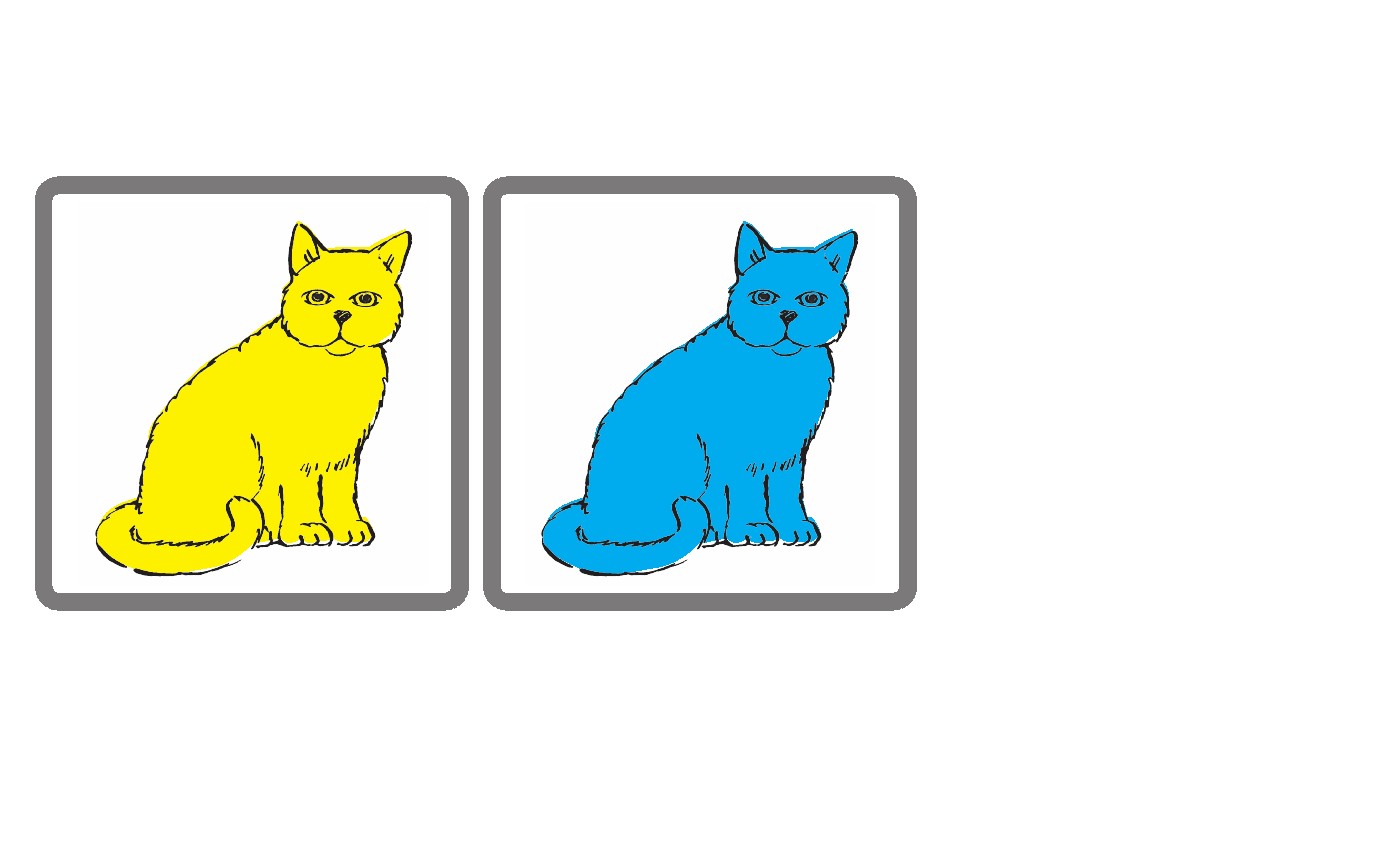 42
42
Item Selection
Dimension: cat
Here are two pictures. Something’s the same. They are both cats.
43
Item Selection
 Item
9
Item
9
44
Item Selection
 Item
9
Item
9
Here is another picture. Which of these pictures . . .
[Point to first two pictures.]
. . . is the same as this one?
[Point to the blue flower.]
45
Item Selection
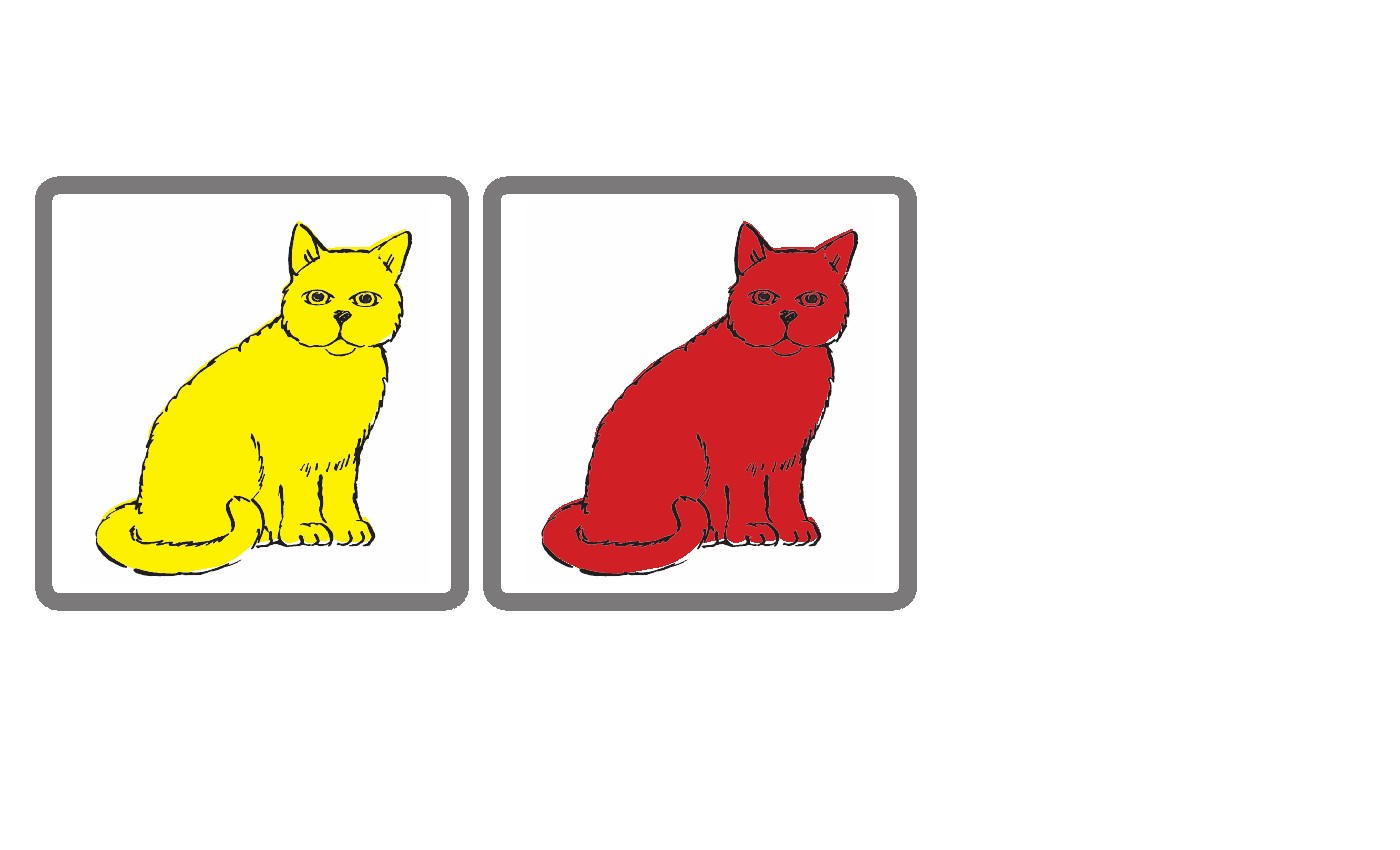 46
46
Item Selection
Dimension: big
Here are two pictures. Something’s the same. They’re both big.
47
Item Selection
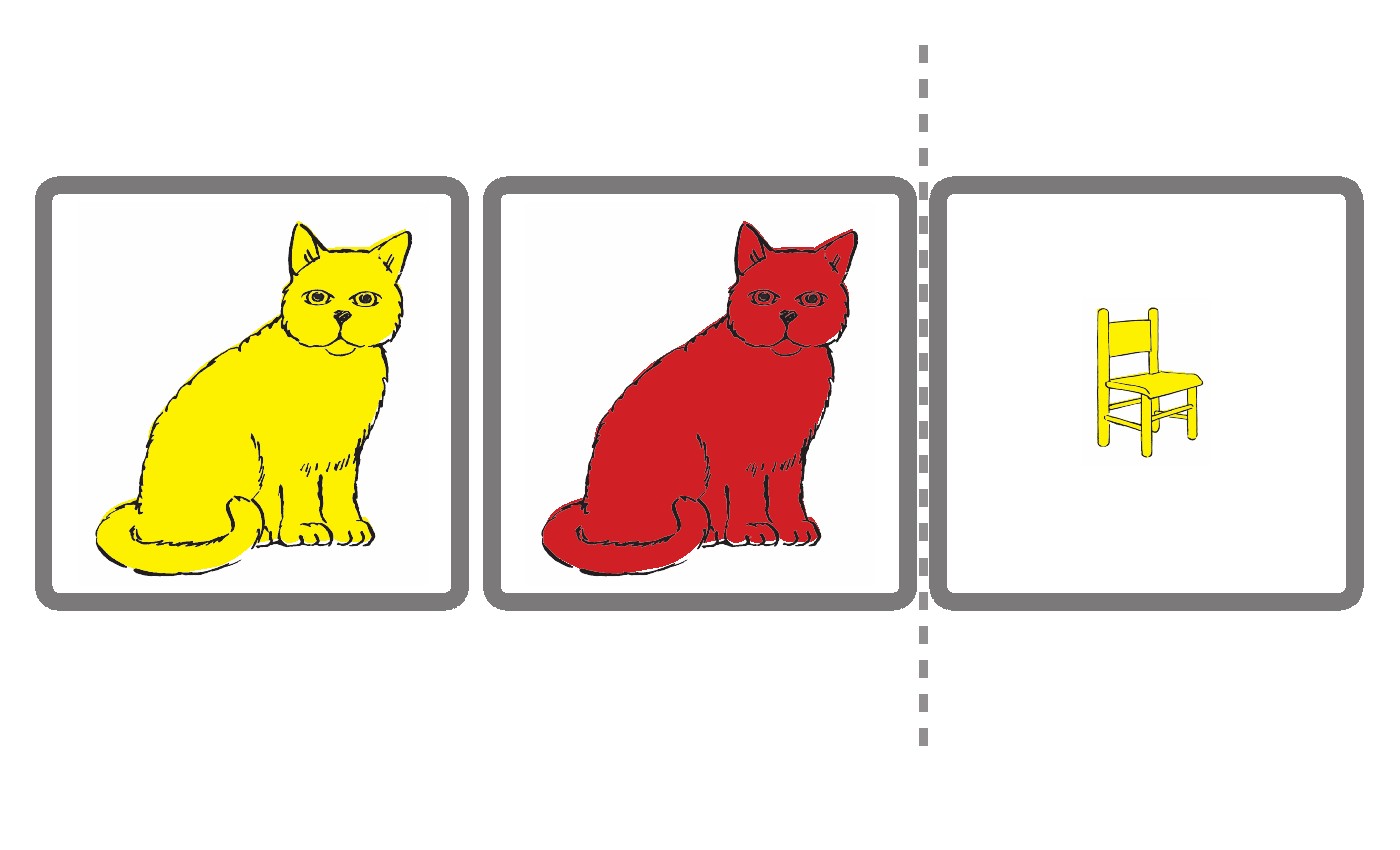 Item
10
Item
10
48
Item Selection
 Item
10
Item
10
Here is another picture. Which of these pictures . . .
[Point to first two pictures.]
. . . is the same as this one?
[Point to the small yellow chair.]
49
Item Selection
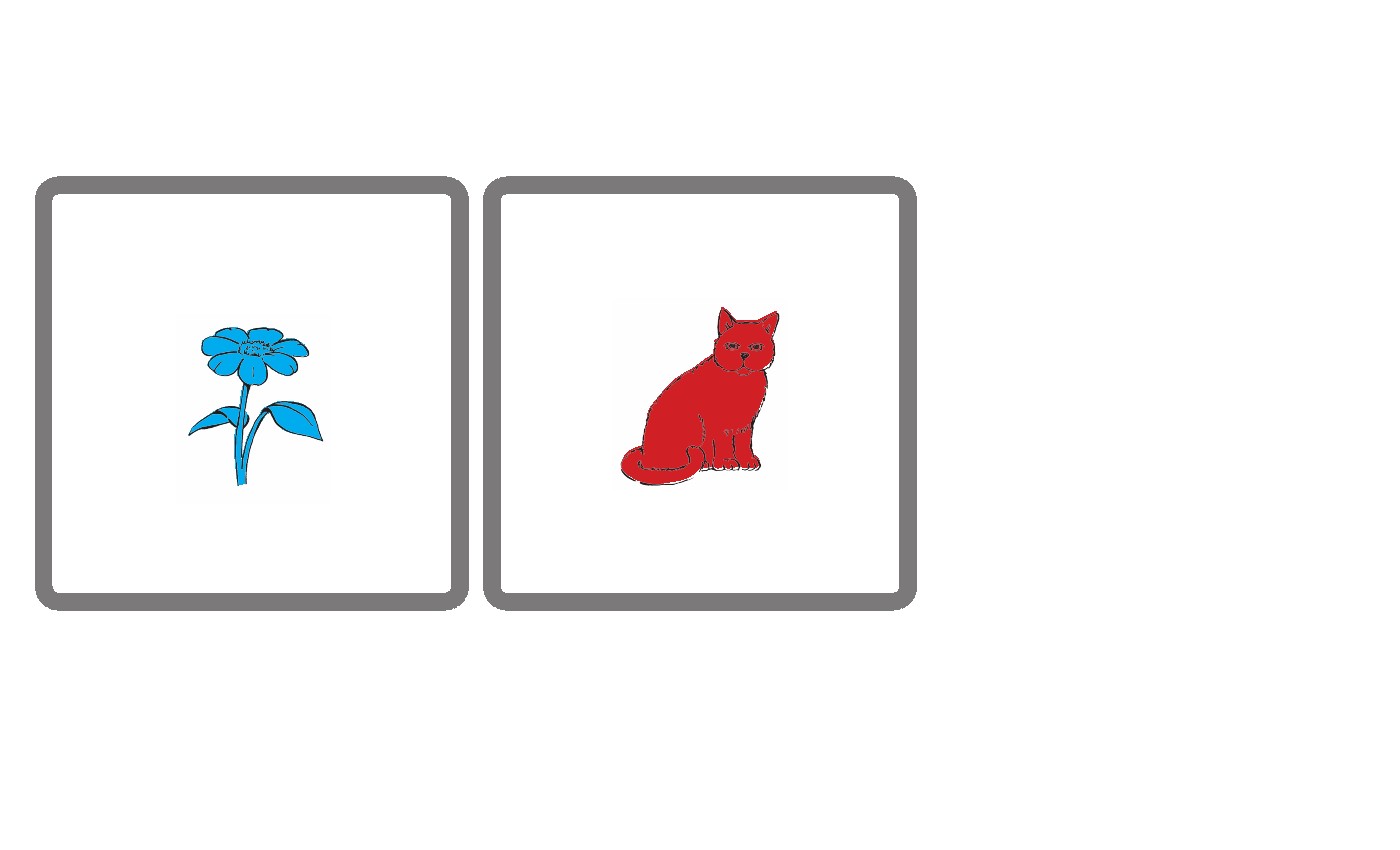 50
50
Item Selection
Dimension: little
Here are two pictures. Something’s the same. They are both little.
51
Item Selection
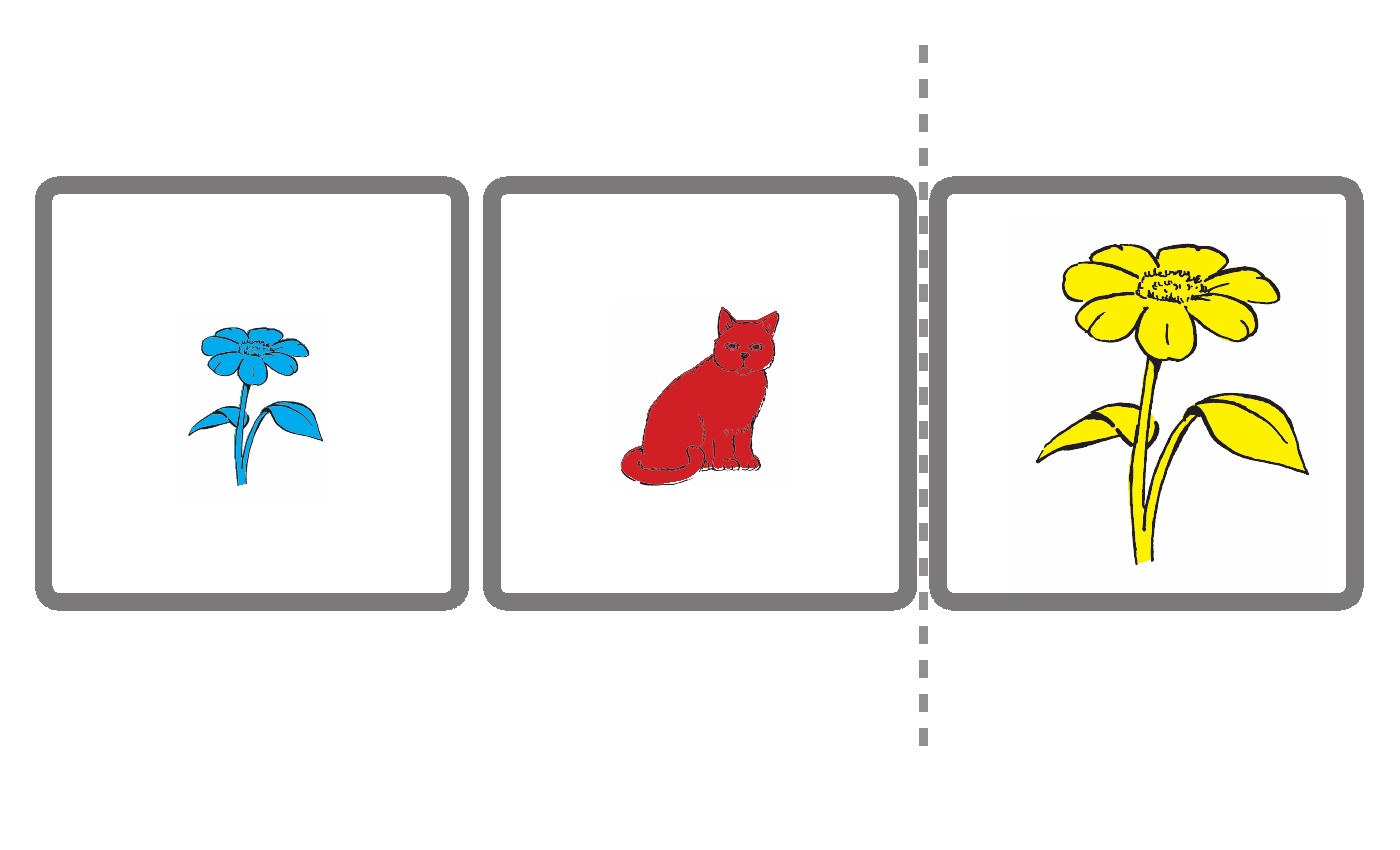 Item
11
Item
11
52
Item Selection
 Item
11
Item
11
Here is another picture. Which of these pictures . . .
[Point to first two pictures.]
. . . is the same as this one?
[Point to the large yellow flower.]
53
Item Selection
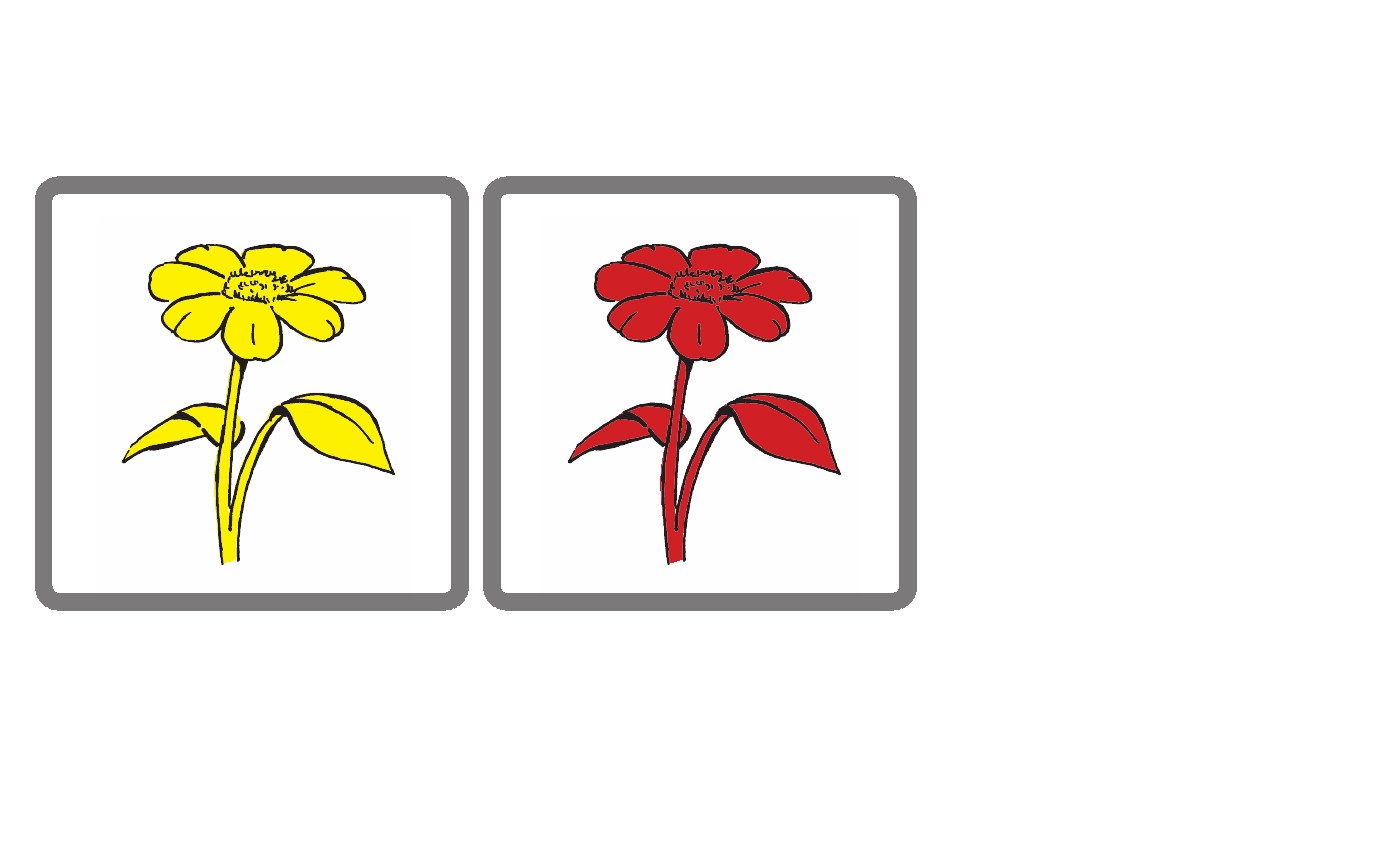 54
54
Item Selection
Dimension: flower
Here are two pictures. Something’s the same. They are both
flowers.
55
Item Selection
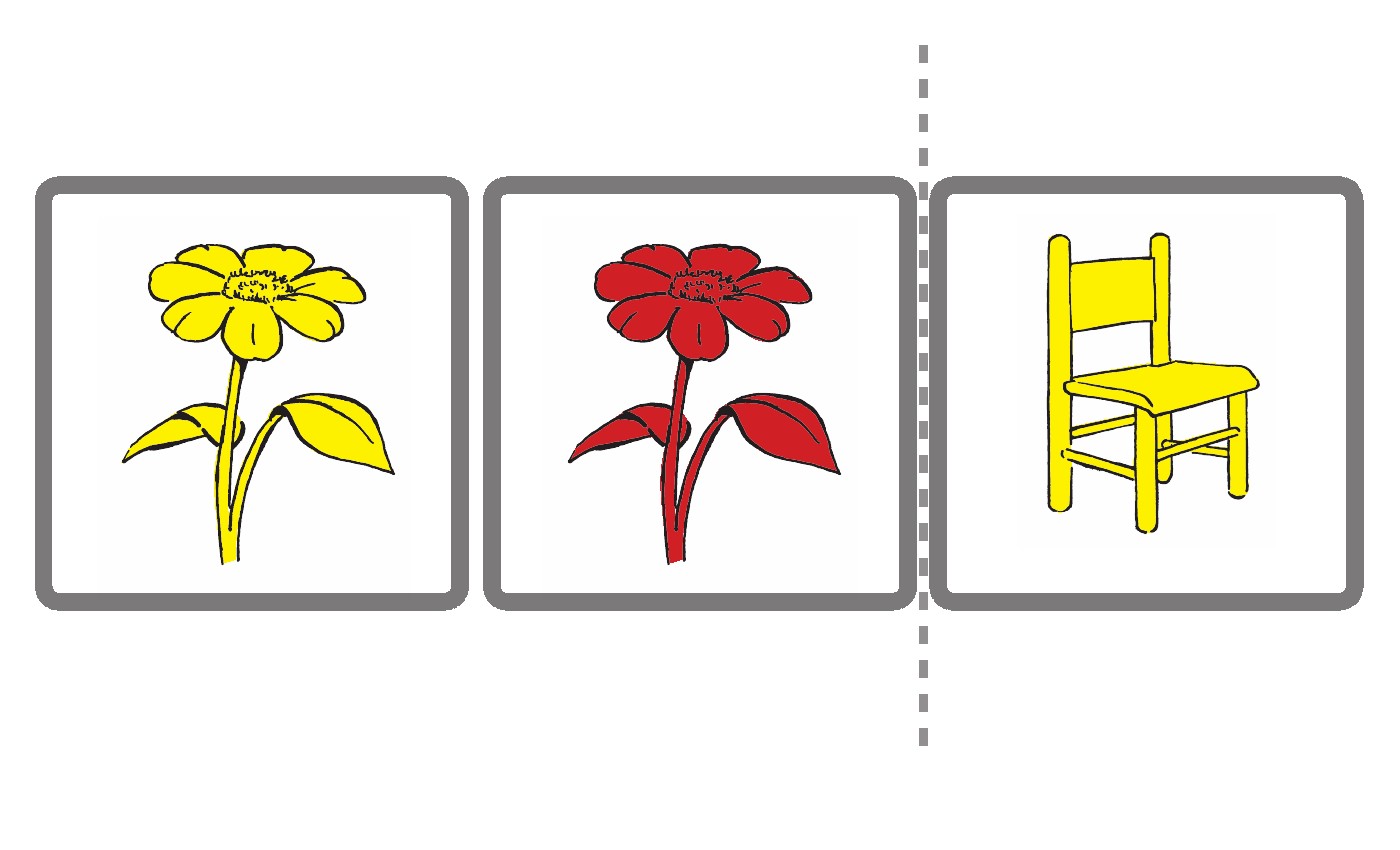 Item
12
Item
12
56
Item Selection
 Item
12
Item
12
Here is another picture. Which of these pictures . . .
[Point to first two pictures.]
. . . is the same as this one?
[Point to the yellow chair.]
57
Item Selection
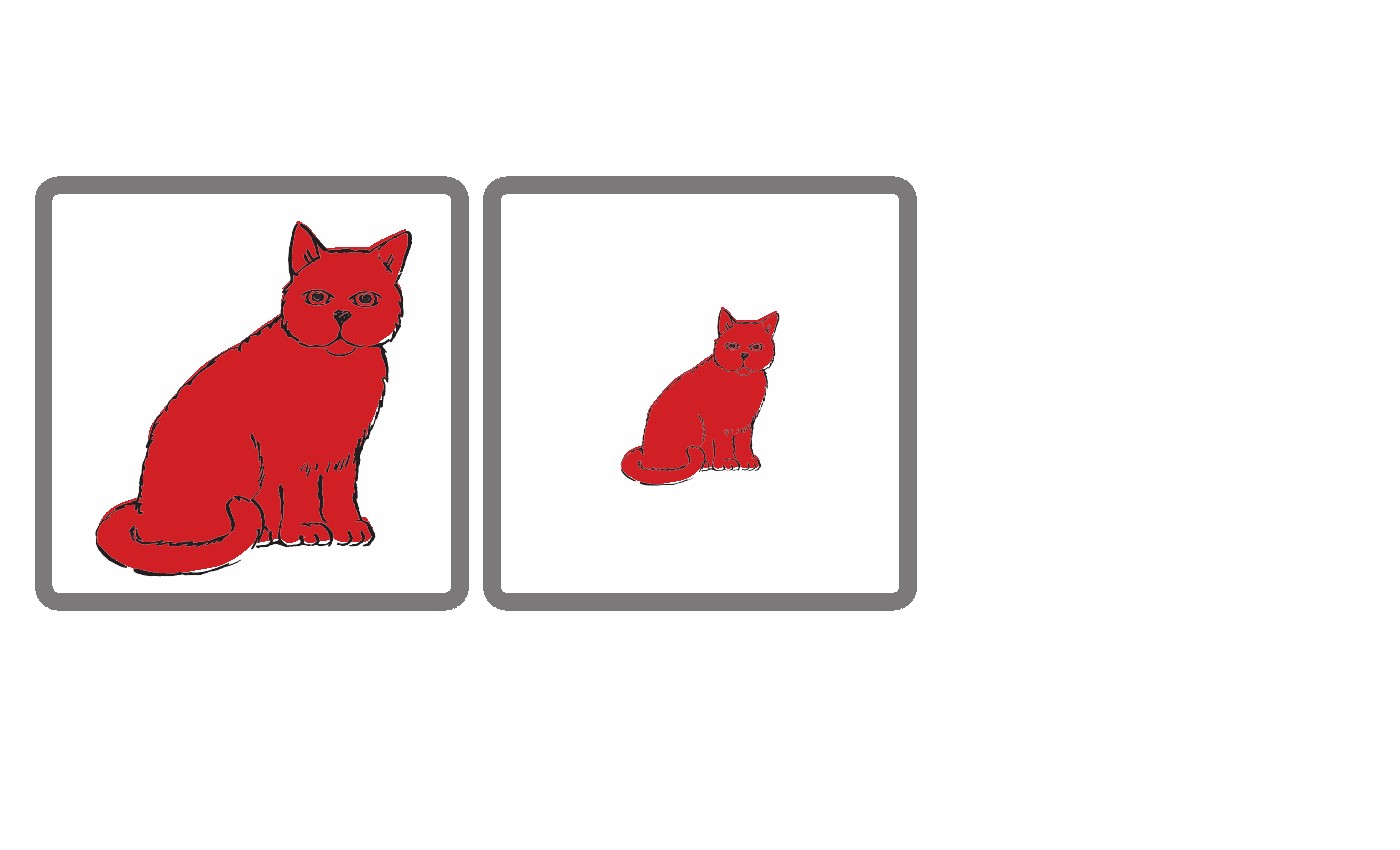 58
58
Item Selection
Dimension: cat
Here are two pictures. Something’s the same. They are both cats.
59
Item Selection
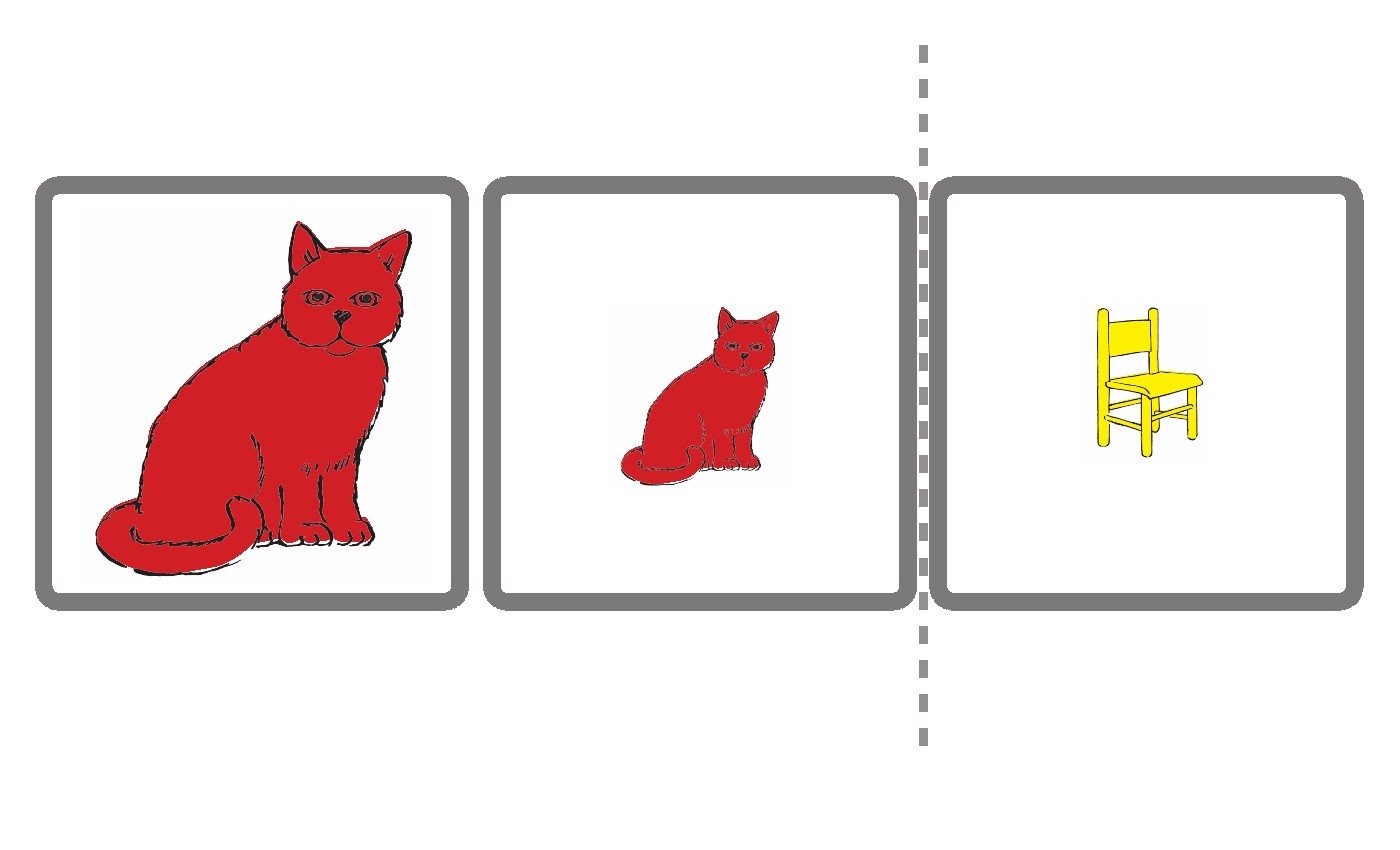 Item
13
Item
13
60
Item Selection
 Item
13
Item
13
Here is another picture. Which of these pictures . . .
[Point to first two pictures.]
. . . is the same as this one?
[Point to the small yellow chair.]
61
Item Selection
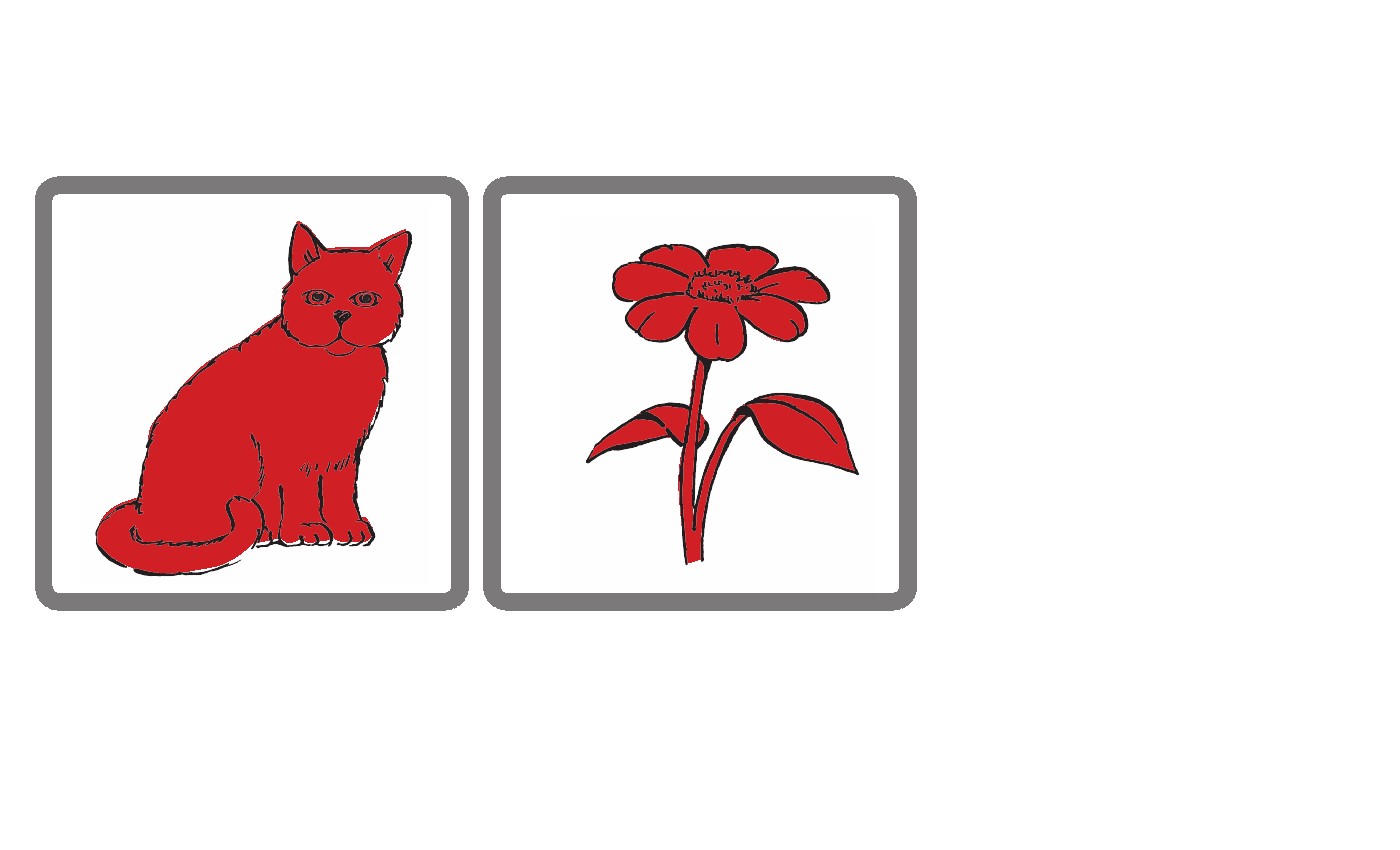 62
62
Item Selection
Dimension: red
Here are two pictures. Something’s the same. They are both red.
63
Item Selection
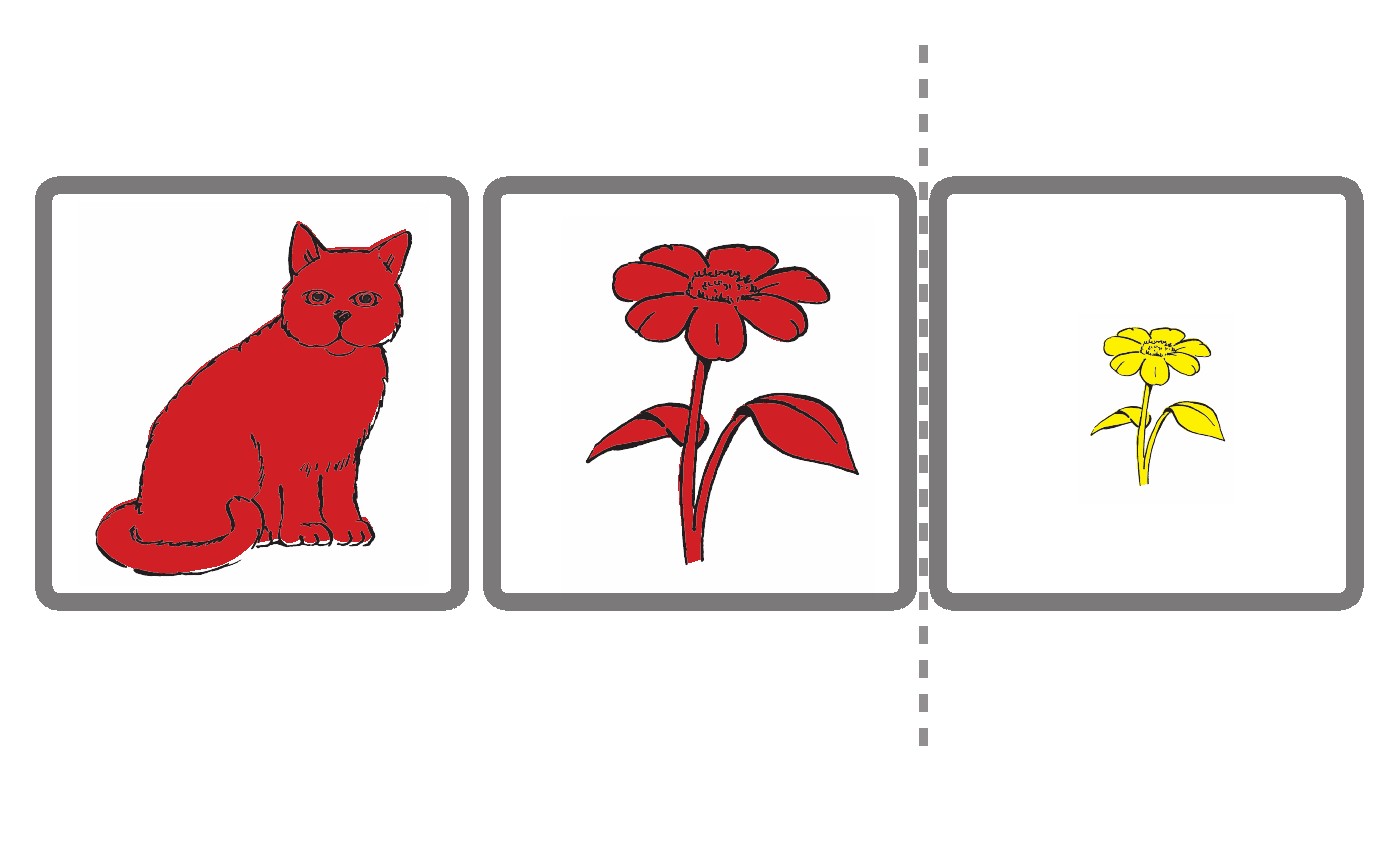 Item
14
Item
14
64
Item Selection
 Item
14
Item
14
Here is another picture. Which of these pictures . . .
[Point to first two pictures.]
. . . is the same as this one?
[Point to the yellow flower.]
65
Item Selection
 66
66
Item Selection
Dimension: chair
Here are two pictures. Something’s the same. They are both chairs.
67
Item Selection
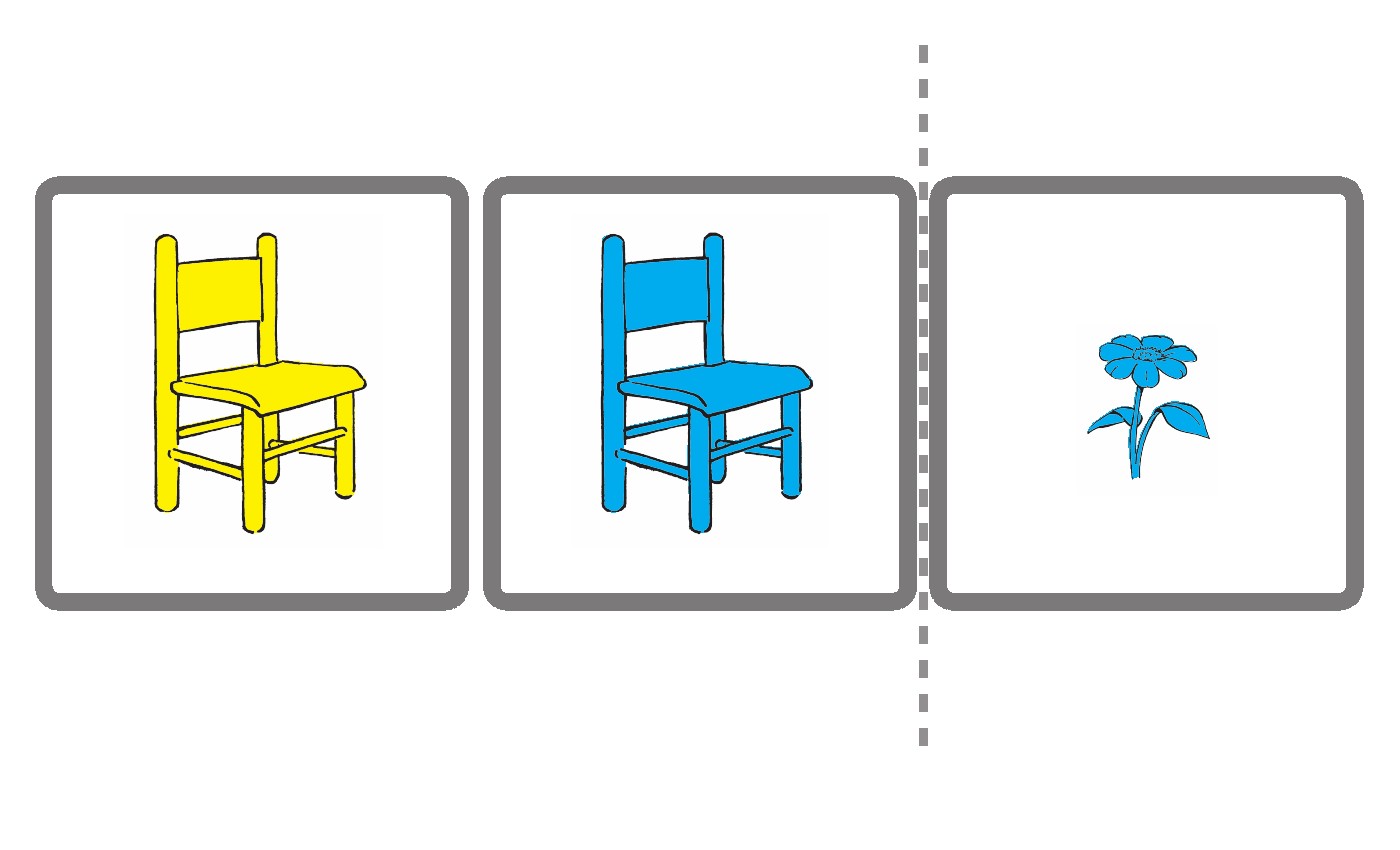 Item
15
Item
15
68
Item Selection
 Item
15
Item
15
Here is another picture. Which of these pictures . . .
[Point to first two pictures.]
. . . is the same as this one?
[Point to the small blue flower.]
69
Item Selection
 70
70
Item Selection
Dimension: big
Here are two pictures. Something’s the same. They are both chairs.
71
Item Selection
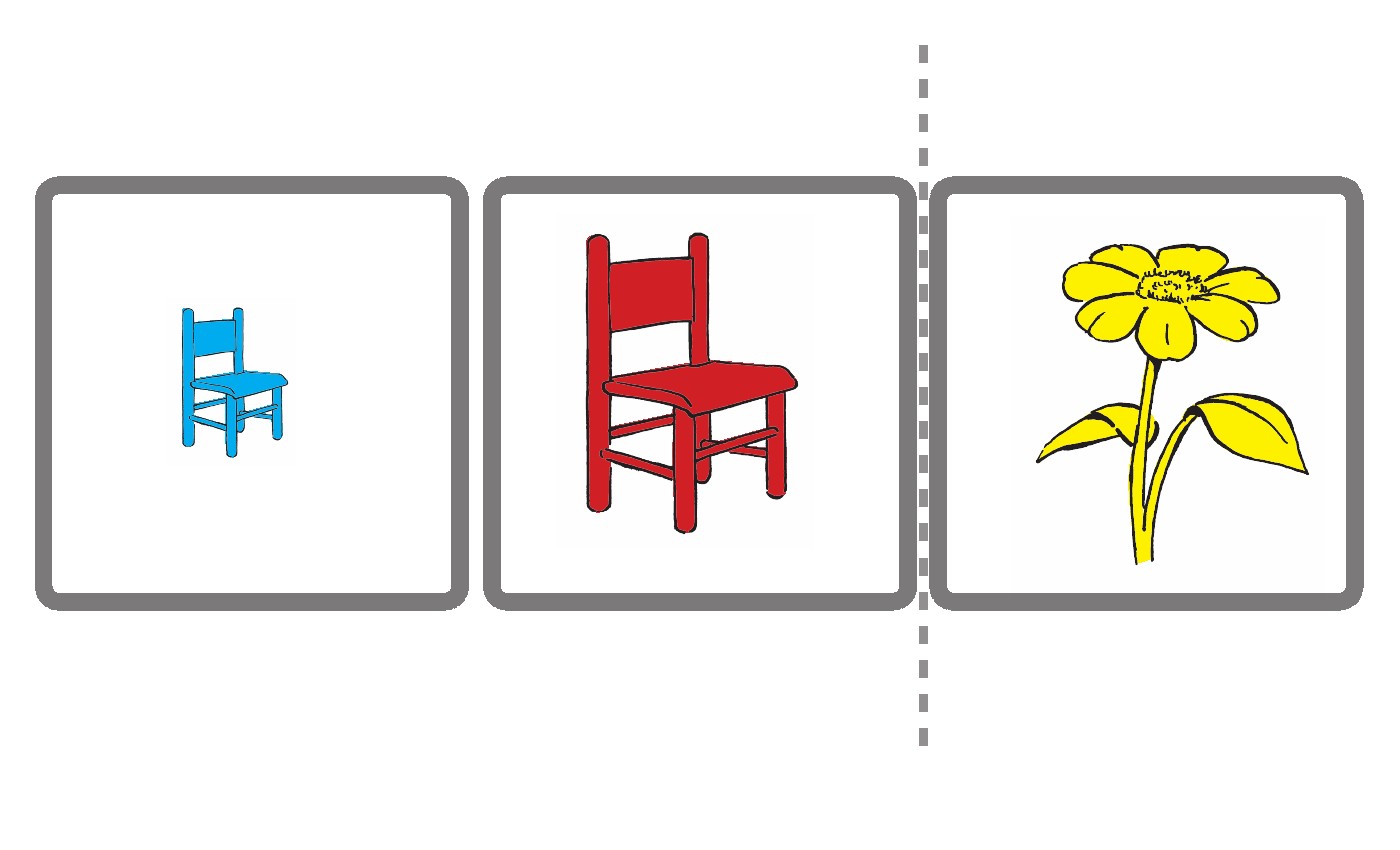 Item
16
Item
16
72
Item Selection
 Item
16
Item
16
Here is another picture. Which of these pictures . . .
[Point to first two pictures.]
. . . is the same as this one?
[Point to the big yellow flower.]
73
Item Selection
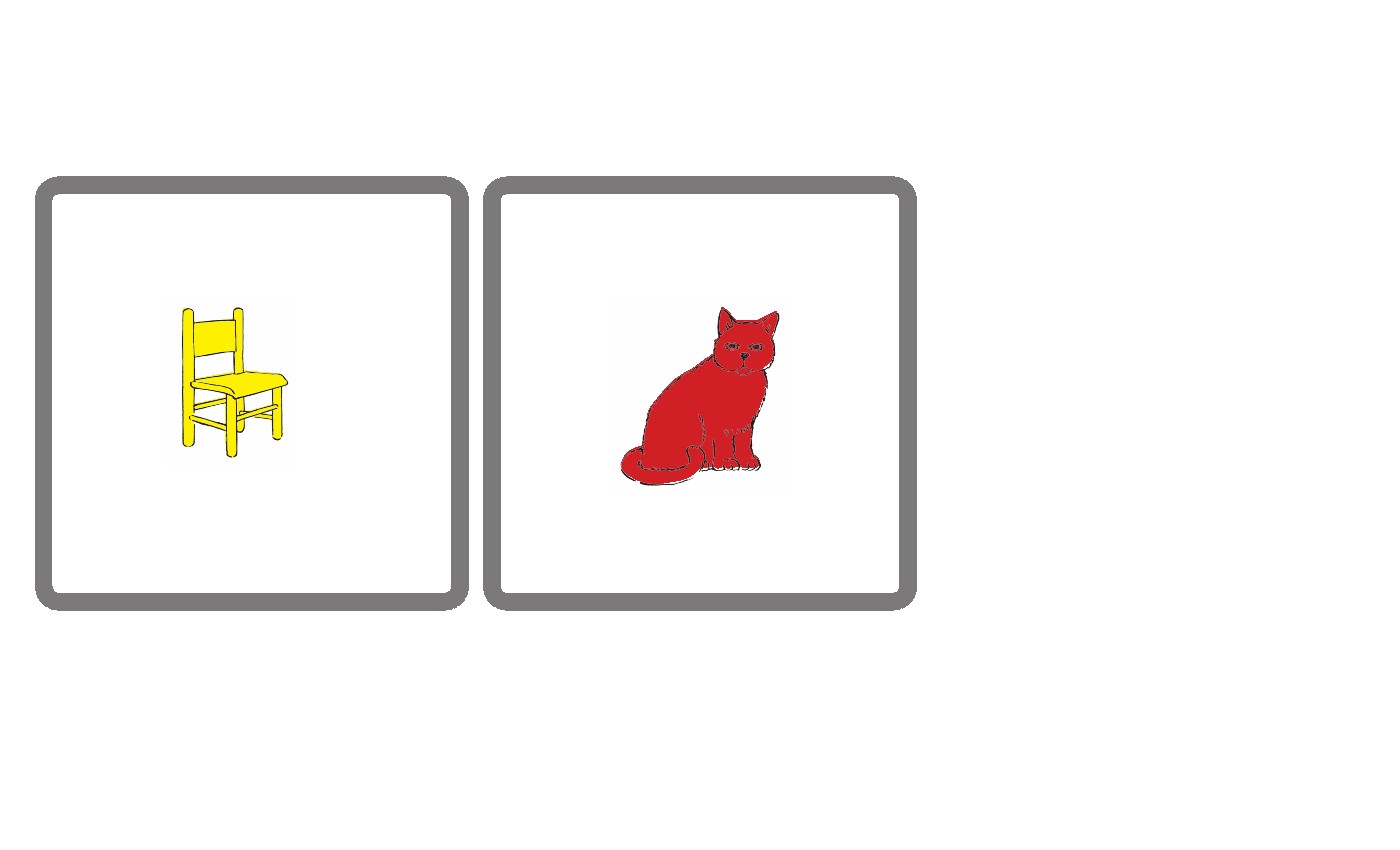 74
74
Item Selection
Dimension: small
Here are two pictures. Something’s the same. They are both small.
75
Item Selection
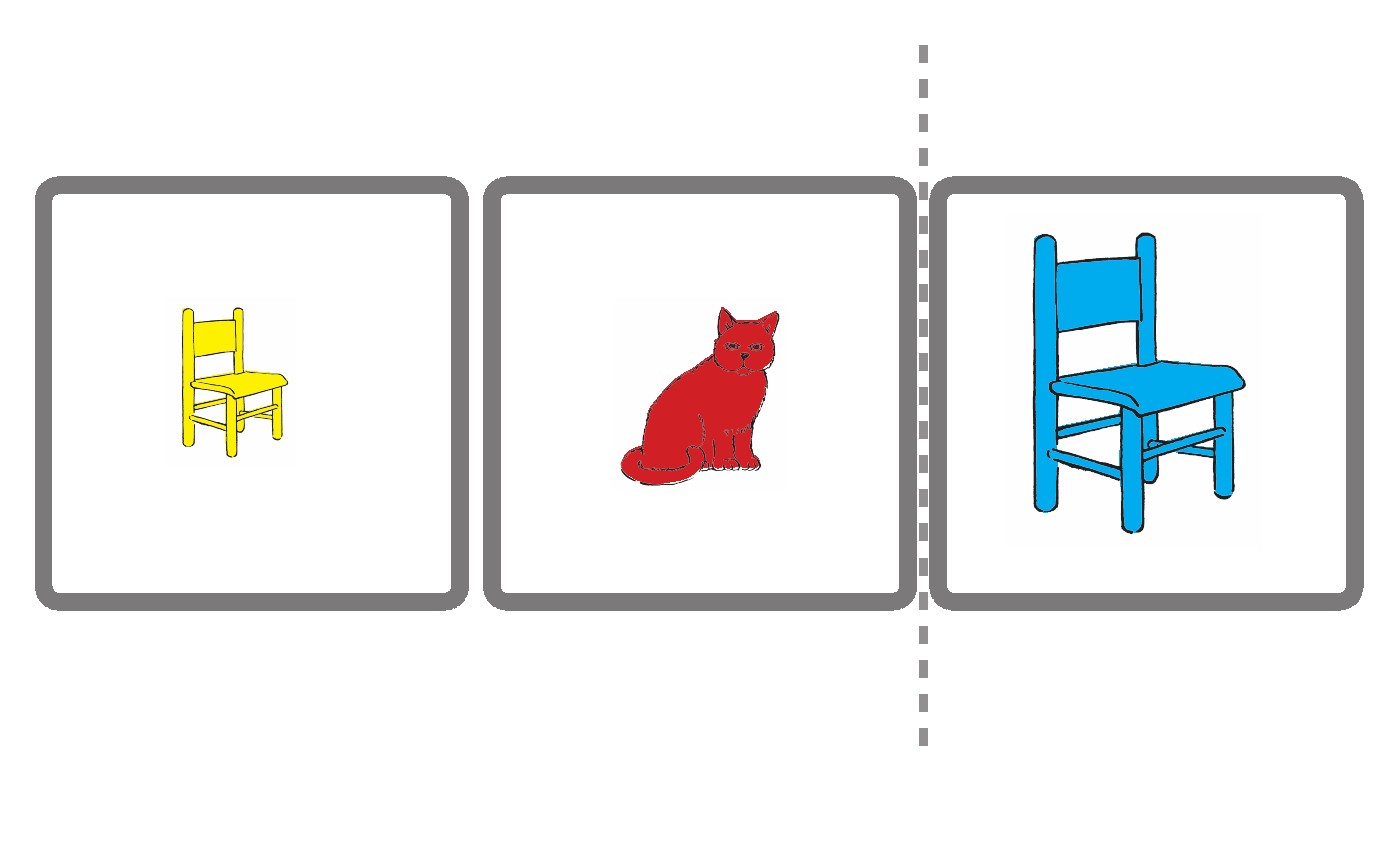 Item
17
Item
17
76
Item Selection
 Item
17
Item
17
Here is another picture. Which of these pictures . . .
[Point to first two pictures.]
. . . is the same as this one?
[Point to the big blue chair.]
77
Item Selection
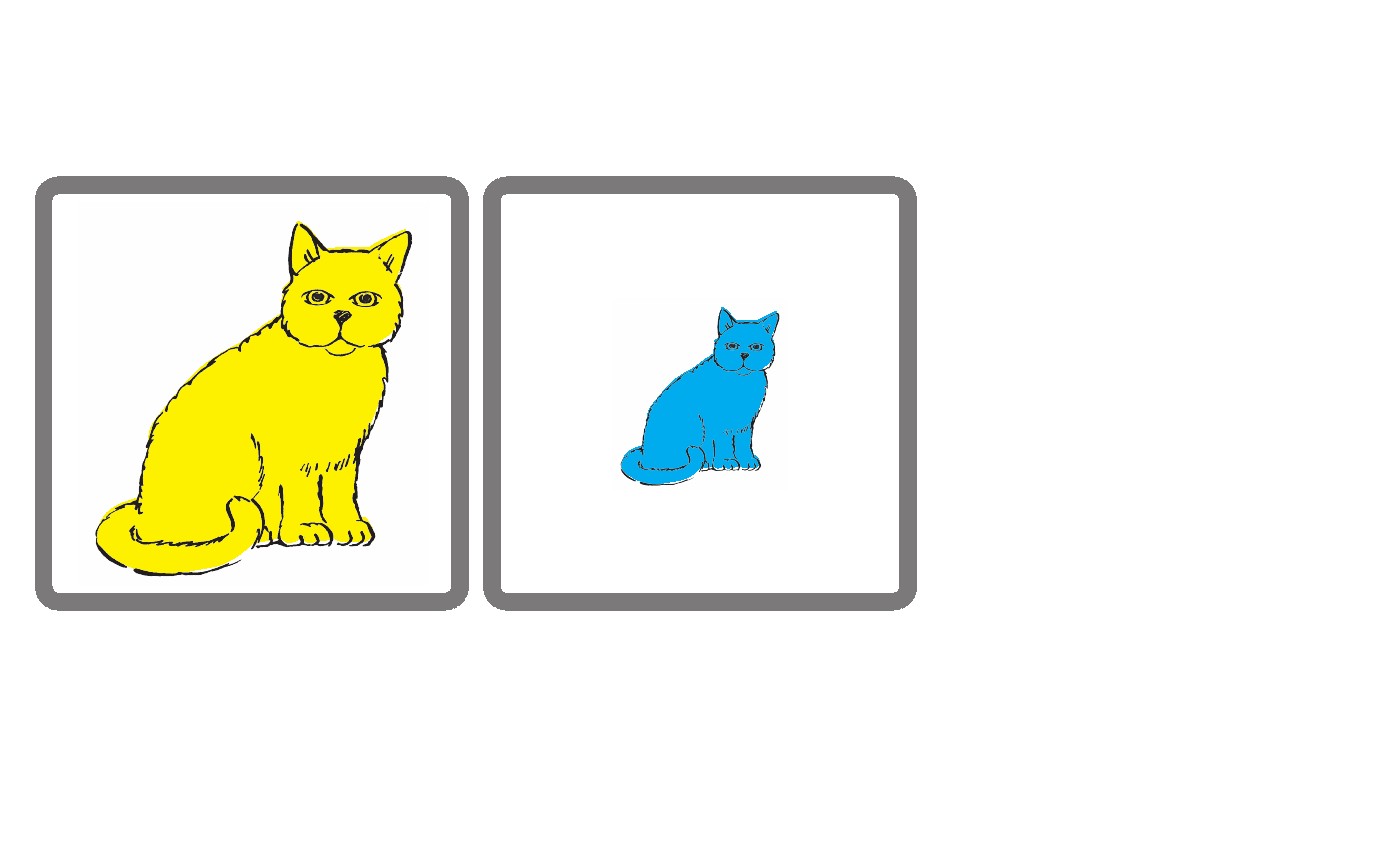 78
78
Item Selection
Dimension: cats
Here are two pictures. Something’s the same. They are both cats.
79
Item Selection
 Item
18
Item
18
80
Item Selection
 Item
18
Item
18
Here is another picture. Which of these pictures . . .
[Point to first two pictures.]
. . . is the same as this one?
[Point to the big red chair.]
81
Item Selection
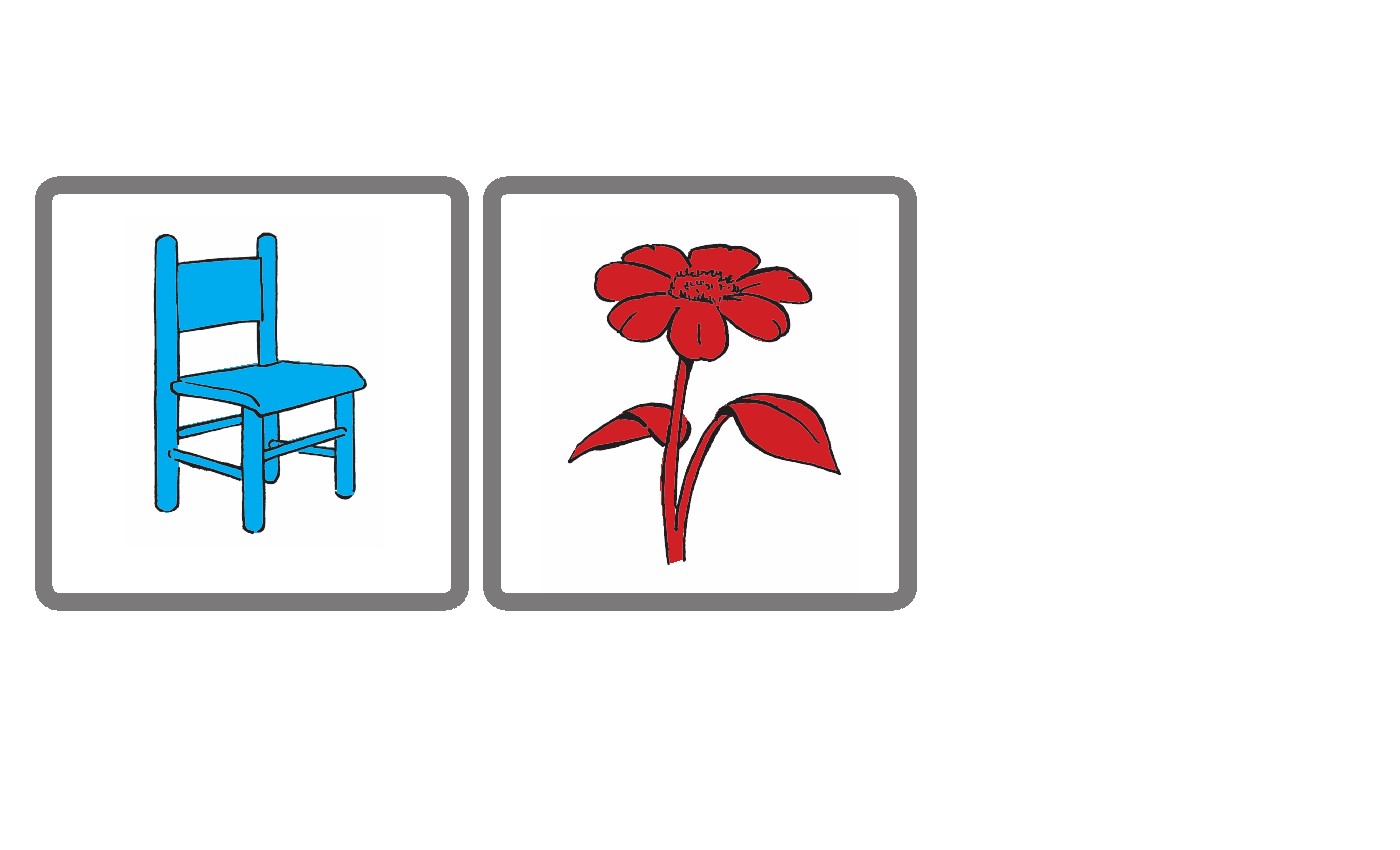 82
82
Item Selection
Dimension: big
Here are two pictures. Something’s the same. They are both big.
83
Item Selection
 Item
19
Item
19
84
Item Selection
 Item
19
Item
19
Here is another picture. Which of these pictures . . .
[Point to first two pictures.]
. . . is the same as this one?
[Point to the small yellow flower.]
85
Item Selection
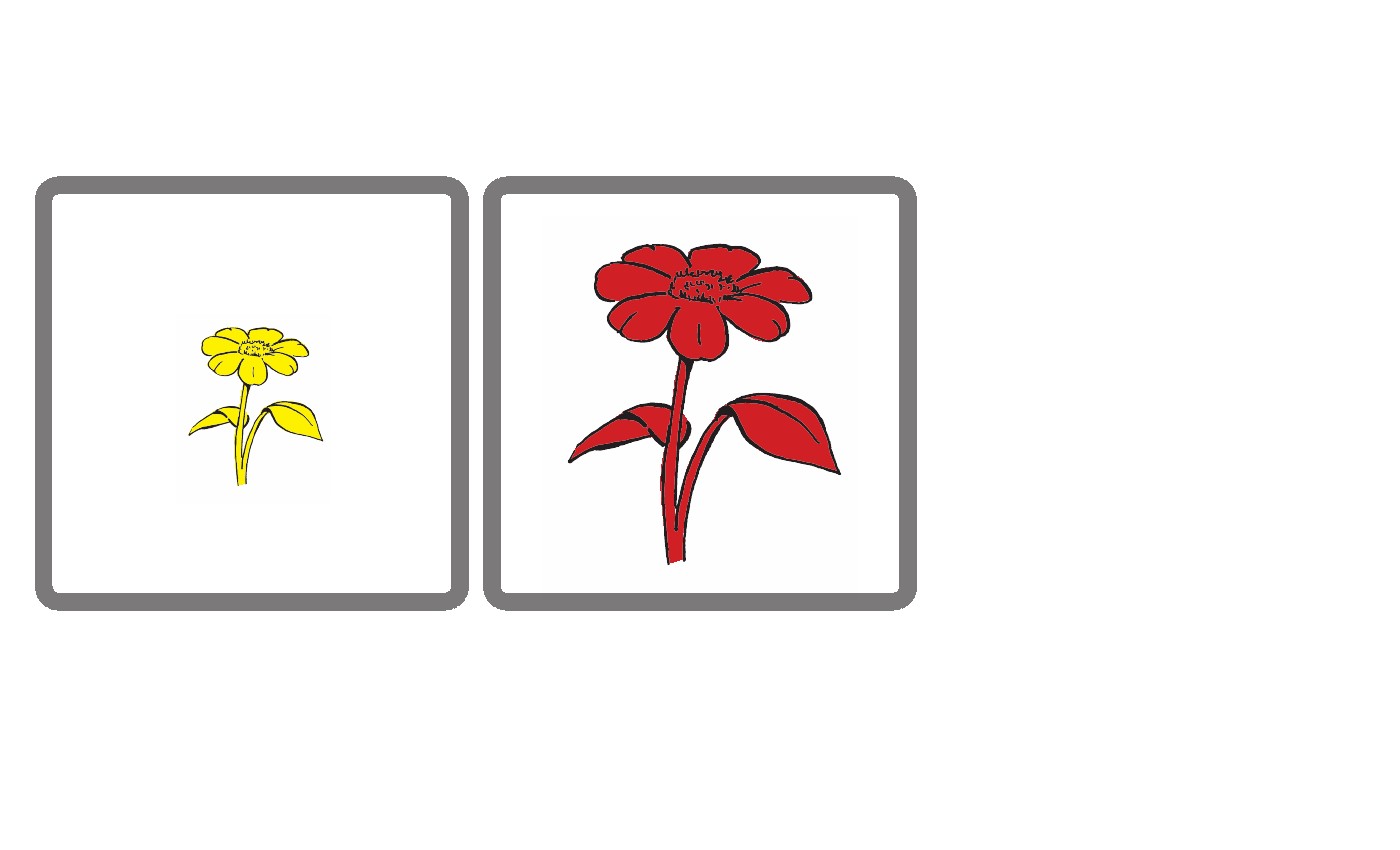 86
86
Item Selection
Dimension: flower
Here are two pictures. Something’s the same. They are both flowers.
87
Item Selection
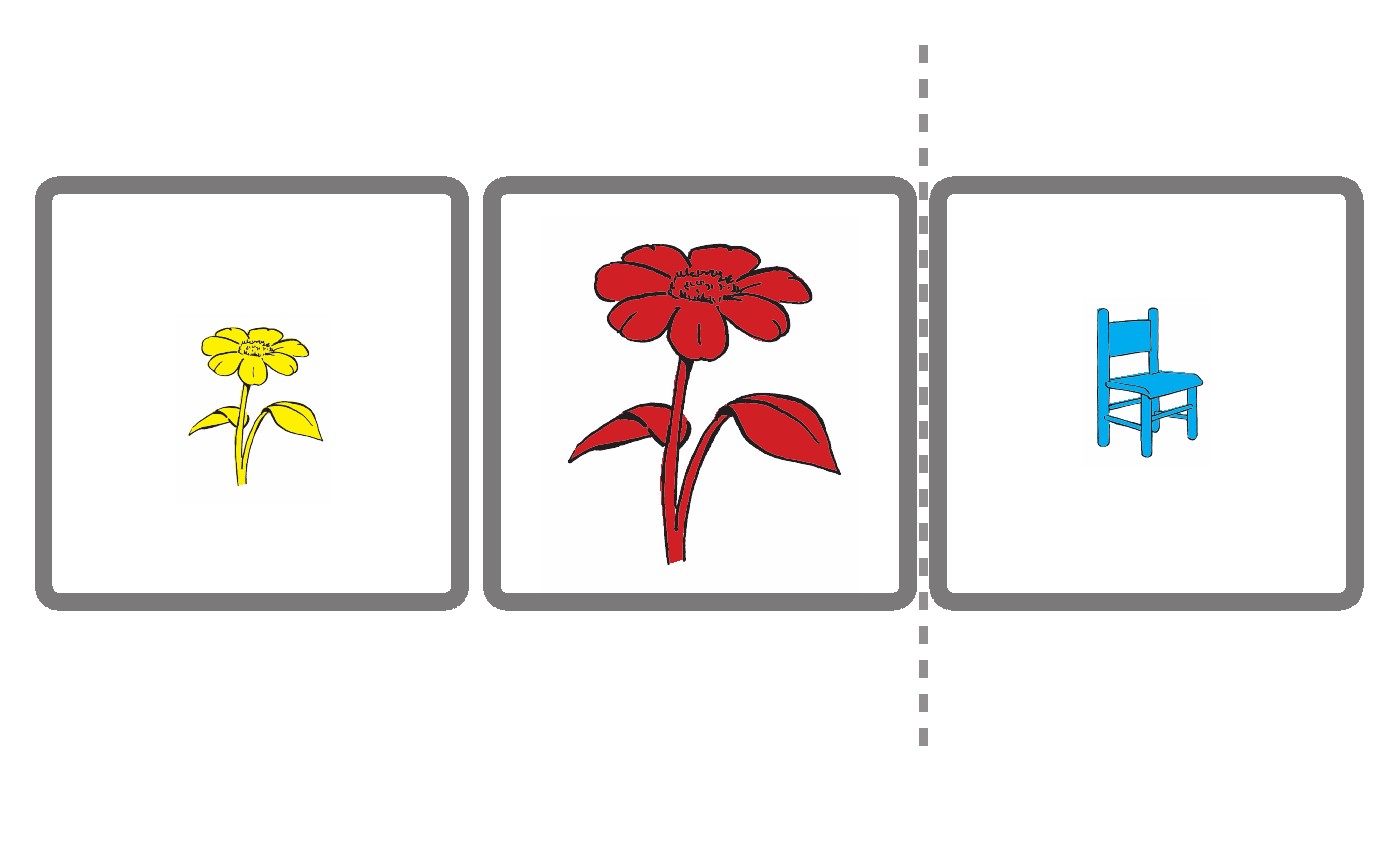 Item
20
Item
20
88
Item Selection
 Item
20
Item
20
Here is another picture. Which of these pictures . . .
[Point to first two pictures.]
. . . is the same as this one?
[Point to the small blue chair.]
89
Item Selection
| File Type | application/msword |
| Author | Ximena Portilla |
| Last Modified By | DHHS |
| File Modified | 2009-02-17 |
| File Created | 2009-02-17 |
© 2025 OMB.report | Privacy Policy